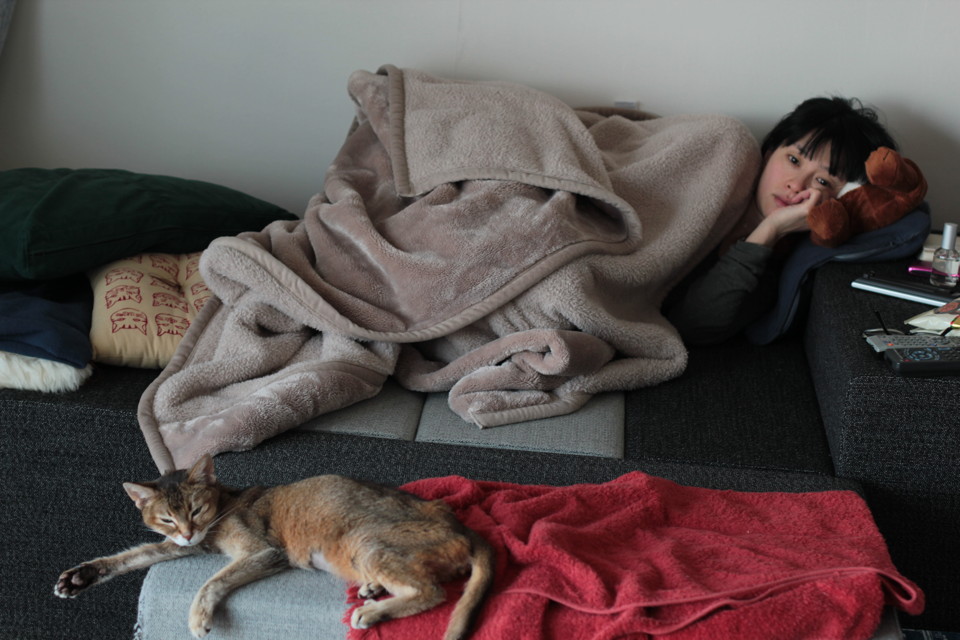FROM JAPAN
sleeping beauty

We all have experienced seeing our vegetables getting wilted in the refrigerator, which were full of water and energy when we picked them up on the market. But after a few busy days when we finally want to use the vegetables, we find an altered appearance. Lifestyle has changed dramatically in terms of economic situation and our life has become busier and busier. Naturally both wife and husband work and there is less “housewife” archetype who can spend enough time for shopping everyday.
We all know how tasty it is to pick up vegetables from the market every morning and eat them, but this seems to be so called “daily luxury”. Also from the research data, more and more people are anxious about “lack of vegetables & fruits” in their daily life, they even take a smoothie instead of coffee on a daily basis, taking fresh vegetables is a big matter nowadays.
Recently I found two interesting directions for refrigerators, which have been developed by two home electronic companies in Japan.Both companies focus on “how to keep vegetables fresh in the refrigerator as long as possible” but come up with totally different answers.
HITACHI who is one of the leading companies for technology and social solution has introduced new technology for refrigerators.
To keep the vegetables “young and fresh”, their idea is to let vegetables sleep in the refrigerator like the story “ sleeping beauty”. They have collaborated with HOKKAIDO University to develop the platinum catalyst which works functionally even in the low temperature and to disassembly the Ethylene gas from vegetables and make carbon dioxide gas out of it.
It keeps the concentration of carbon dioxide gas in the space to let vegetables sleep and not loose their youngness, like a fairytale. If it would be compared with a fridge without this function, it will keep more than 90 % of water in the vegetable after “sleeping” without any wrapping for one week.The magic moment of sleeping beauty’s wake up is not by the kiss of a prince but when we open the refrigerator and eat.
On the other hand, there is another trial to keep freshness of vegetables done by MITSUBISHI ELECTRICS. To keep the vegetables fresh they focus on changes in the sun’s rays of the day and imitate the sunray’s change by using LED light. Starting with 2 hours in the morning, they use 3 colors, blue, red and green, and 10 hours in the daytime with red and green, and 12 hours of turning off. By making a change in the cycle of light in the refrigerator it succeeds in keeping the freshness of vegetables by utilizing the mechanism of photosynthesis. With the gentle smile of “sunshine” in the refrigerator, the vegetables continues to grow slowly as if they were still in the farm, and as a result, not only keeping freshness, but also succeeded in raising the amount of vitamins and sugar in the vegetables.
From this new development, we can read two important messages for creation. Nature is a great resource for innovation indeed and also fantasy has another function to think about things differently, and it is this combination that is our human being’s creativity.
Kaori Ieyasu - From Japan
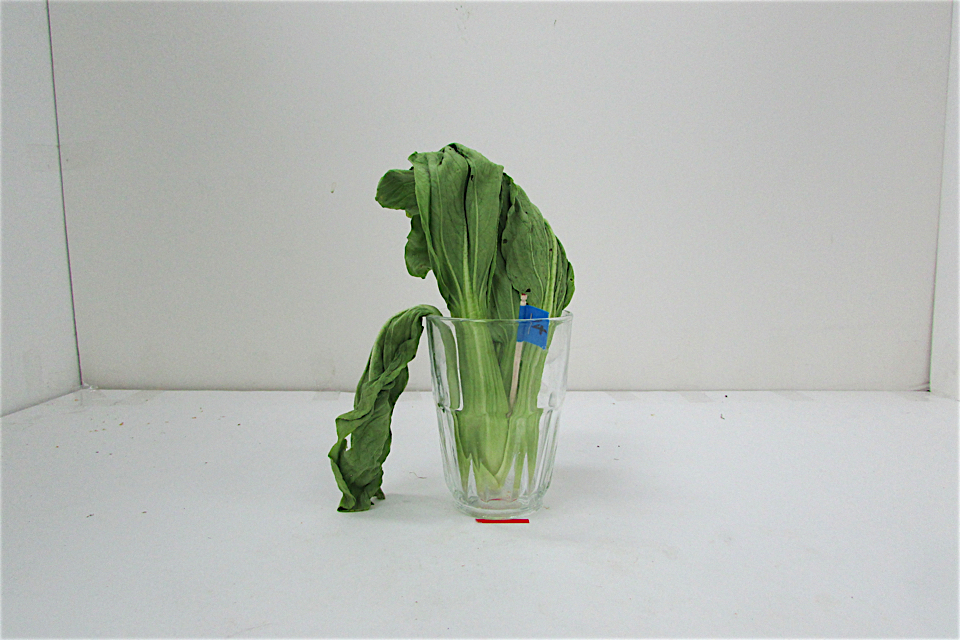
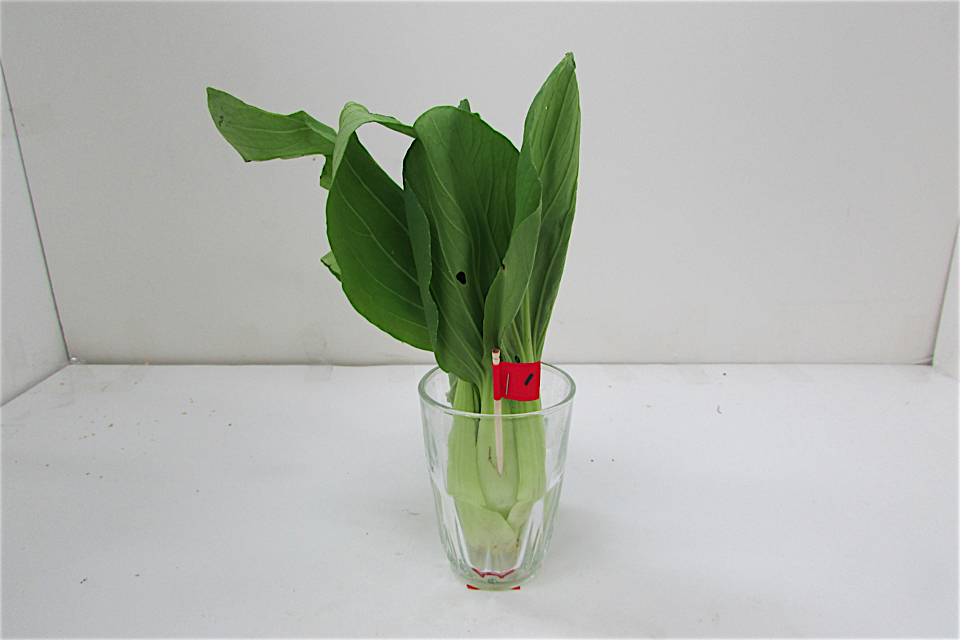
the work of issey miyake
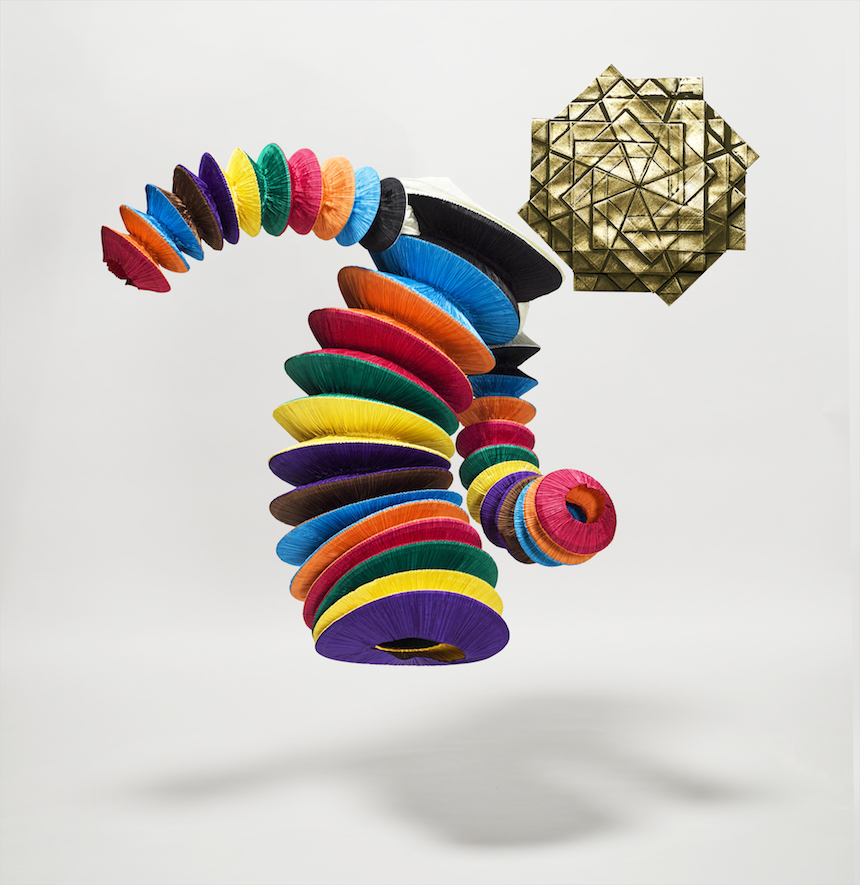
Flying Saucer, Spring/Summer 1994, 1993 - photo: Koji Udo
« Never fully satisfied by his success, Issey Miyake has constantly taken his curiosity one step further, driving his teams mad with his constant and challenging requests. The story of his life has been landscaped by creative encounters with people from all other disciplines such as artists, designers, choreographers and photographers, feeding his thirst for knowledge. Rarely before has such creativity ever existed.” - Lidewij Edelkoort
Issey Miyake has consistently presented new methodologies and possibilities for making clothes, while always focusing on the future. It all began in 1960 when Miyake, a student at Tama Art University, sent a letter to the World Design Conference, which was being held for the first time in Japan that year. The letter took issue with the fact that clothing design was not included in the event. At that point, Miyake’s notion that clothing is not merely “fashion” – i.e., something that changes with the times – but a form of design that is closely connected to our lives on a much more universal level was already apparent. Miyake has always explored the relationship between a piece of cloth and the body, and the space that is created as a result, unrestricted by any existing framework. In addition, along with his team of designers, he persistently undertakes research and development to create clothing that combines both innovation and comfort.
The exhibition « Miyake Issey Exhibition » sheds light on Miyake’s ideas about making things and his approach to design by examining his entire career, from his earliest work to his latest projects, and his explorations of greater creative possibilities in the future. This exhibition provides viewers with an opportunity to expand the boundaries of their thought and stimulate their creativity, allowing everyone, young and old alike, to experience the joy of creation.
Using a single piece of cloth to create a piece of clothing is his main creative quest, but also an ethical choice. By doing so, in fact, he can develop new shapes, while enhancing the beauty and texture of the fabric and reducing its waste to virtually zero, in respect of the environment. As a result, the almost abstract forms that derive from a single piece of cloth free the body from any constriction, while reacting differently to different body shapes, making clothing truly personal, in an unfussy, immediate way. One room in the exhibition explores the main themes of Issey Miyake’s innovative drive and groups them in thematic clusters. A link unites them in a whole, however, because in the design studio cross-pollination is an essential practice.
Fabric is pivotal: a maker of things, Issey Miyake believes that any material can be turned into clothing. He used Japanese washi paper, horsehair and raffia; conversely, he has rediscovered traditional materials. But he has also experimented special treatments giving surfaces an alive, animal look, as well as exploring futuristic fabrics, such as a polyester that is heat-cut and molded into shape with the aid of just snap buttons. Miyake has also developed treatments based on the idea of re-use, like the Starburst series which acquire a new look after the foil is pressed on the fabric surface, or the needle-punching that produces unique textures by laying layers of different materials.
Pleats is a theme that crosses a large dent of the Miyake production. Working first with blends of polyester and natural fibers, then with a specially developed weave of polyester that can be heat processed, Issey Miyake turned pleats, one of the most ancient ways to wrap a three dimensional object with a two-dimensional material, into an expression of aesthetic pureness with a pragmatic aim. He developed a special process of “garment pleating”, which means that a piece of clothing is pleated after it is sawn, resulting in very sharp, defined lines. Pleats allowed Miyake the opportunity of working with shapes that laid flat have almost a purely abstract quality - a staircase, a circle, a flying saucer - playing with the space between body and clothing, but pleats and specifically the “garment pleating” process he devised, ultimately provided the solution to one of Miyake’s dreams to create clothing as universal as jeans and T-shirts, and allowed the creation of a whole new species of utilitarian clothes, at once inventive, sturdy and extremely practical. Freeing the movement was the aim, and in fact these solutions were first tested for the William Forsythe’s Ballet Frankfurt, and later introduced into the collection, finally culminating in the launch of PLEATS PLEASE in 1993. The exhibition actively shows the pleating process as well, revealing the keen engineering that is required in order to pleat a piece that is already sewn.
Making things: this is how Issey Miyake defines his activity. Wearable things, in his views, have to be made in respect of the individual as well as in respect of the environment. A-POC and 132 5. ISSEY MIYAKE are the result of such convictions, almost thirteen years apart from one another. A-POC is a revolutionary process that Miyake developed with Dai Fujiwara in 1998, that allows to shape clothes integrally through the production of a tubular piece of knit fabric, virtually erasing all waste while doing away with cutting and sewing. Starting in knit, and evolving in wovens, A-POC is the one piece of cloth quest brought to levels of groundbreaking invention.
Launched in 2010, 132 5. ISSEY MIYAKE has been developed inside Miyake’s Reality Lab., a think tank cum design collective crossing boundaries and disciplines. Using recycled polyester as material and techniques inspired by the algorithms, a new breed of clothes is born: items that can be completely folded into flat, geometric shapes, and that only gain life through the body movements of those who unfold them and wear them. As such, this technology has been extended beyond clothes making: similar shapes made with the same folding technique characterize in fact the IN-EI ISSEY MIYAKE lamps made with recycled PET bottles.
MIYAKE ISSEY EXHIBITION: The Work of Miyake Issey
March 16 – Mon., June 13, 2016 at The National Art Center, Tokyo
www.nact.jp

MIYAKE ISSEY EXHIBITION: The Work of Miyake Issey - installation view at the National Art Center, Tokyo - photo: Masaya Yoshimura

MIYAKE ISSEY EXHIBITION: The Work of Miyake Issey - installation view at the National Art Center, Tokyo - photo: Masaya Yoshimura

MIYAKE ISSEY EXHIBITION: The Work of Miyake Issey - installation view at the National Art Center, Tokyo - photo: Masaya Yoshimura

MIYAKE ISSEY EXHIBITION: The Work of Miyake Issey - installation view at the National Art Center, Tokyo - photo: Masaya Yoshimura

MIYAKE ISSEY EXHIBITION: The Work of Miyake Issey - installation view at the National Art Center, Tokyo - photo: Masaya Yoshimura

MIYAKE ISSEY EXHIBITION: The Work of Miyake Issey - installation view at the National Art Center, Tokyo - photo: Masaya Yoshimura

MIYAKE ISSEY EXHIBITION: The Work of Miyake Issey - installation view at the National Art Center, Tokyo - photo: Masaya Yoshimura
time to love
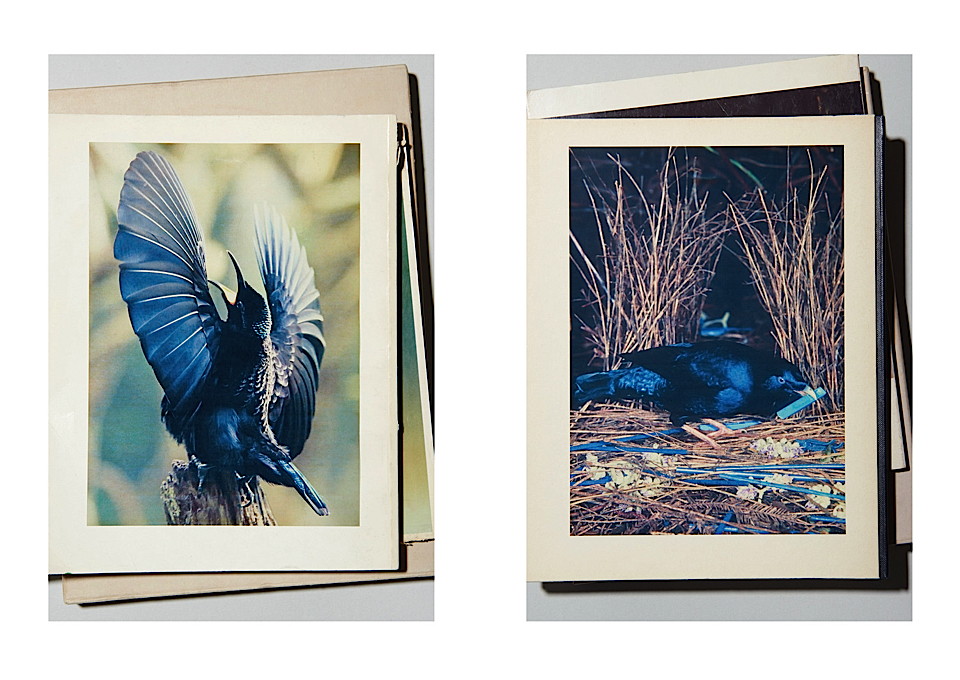
Nowadays, we can perceive the changes occurring in our society in many ways, from social issues to fashion. In this radical changing period we can also witness various feelings regarding relationships, especially between man and woman, which is facing a drastic change.
In the Japanese traditional society, it was considered normal that women got married before reaching the age of 30, having kids and becoming a housewife. However, in the late 1980’s women got the right to choose their life, getting jobs like the men and having a successful career. Couples are currently getting married later and some even prefer to not have children to preserve their freedom. Time has drastically changed; we went through a tough economic crisis, which lasted longer than predicted and also faced painful earthquake disasters. Therefore, it is obvious that the mind has changed in a dramatic way, people want to be much more together than before. This is of course also associated with the SNS boom, seeking to socialize with the unknown and connecting with friends of friends. We also see an increase in sport and culture group activities, but in this issue, I want to talk mainly about men and women.
In the government statistics, the average age of getting married is currently 30.7 for men and 29 for women – which is 3 to 4 years older than the average of 30 years ago. It is said that the tendency of delaying marriage is due to women working in society. Is this really the absolute truth? I doubt this conclusion.
I have recently perceived that many novels and comics where marriage is a subject tend to always include fear of living a life alone, not being able to get married and dying without a loved one. In those stories, the age of the protagonist seems to frequently be around 30. It would appear that they are still young to be free from those apprehensions. In spite of public figures, it is clear that recently women seek to get married earlier or are not feeling comfortable with being alone – leading to anxiety regarding their future and relationships with men.
At the start of January, a remarkable exhibition was held at the Hillside Forum of Daikanyama Hillside Terrace in Tokyo, where cultural events occur and where lifestyle driven fashion shops can be found.
“Act of Love” is a research-based exhibition showcasing the natural behaviors of animals, birds and insects when in love – trying to seduce the opposite sex and their sexual encounter. It is supported by Sagami Rubber Industries, the first Japanese condom manufacturer. Professionals studying the behavioral ecology, ranging from professors of universities to the BBC, were asked to correct the data collected and supply the imagery. They also got in touch with artists to collaborate and create art based on courtship behaviors of animals, to demonstrate the endless possibilities of creativity.
A beautifully made visual dictionary and website offer the public a breathtaking peek on the unusual courtship behaviors of 73 animals – using their entire body, sounds, movements and so on. A glimpse of the fascinating investigation can be seen on the website !
Nowadays, we make use of many ways of communications. However, I truly feel that it is time to use our body, facial expression, hair, movement, make-up color, scent of skin and sound of our voice to let each other know what we really feel – how we want to be together and with who we want to be. The time has come to sincerely love someone.
Kaori Ieyasu
www.actoflove.jp
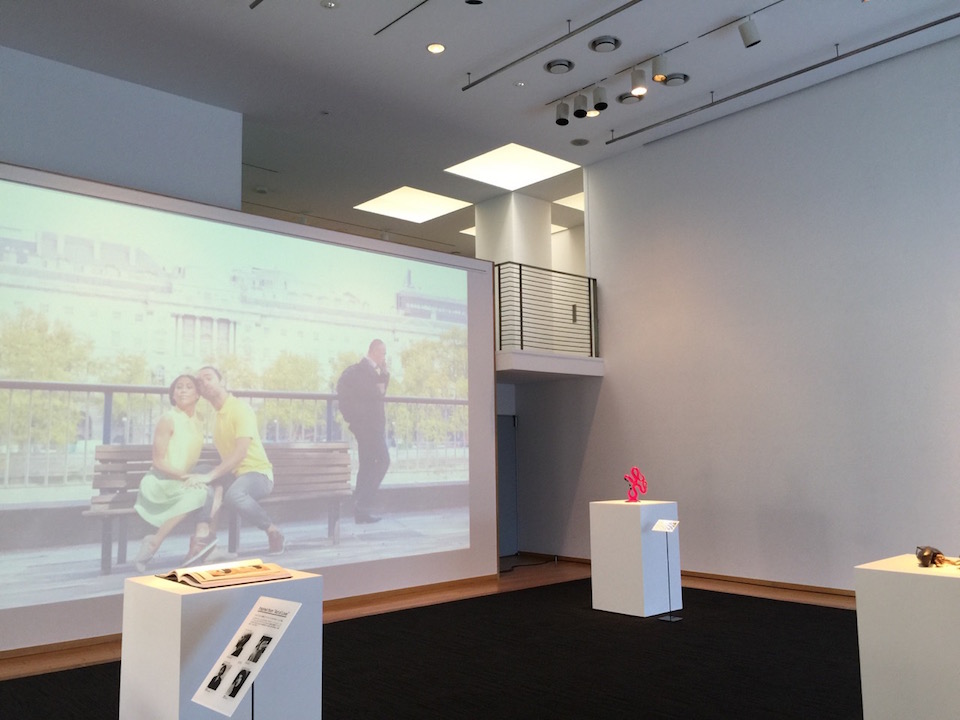

mother & son
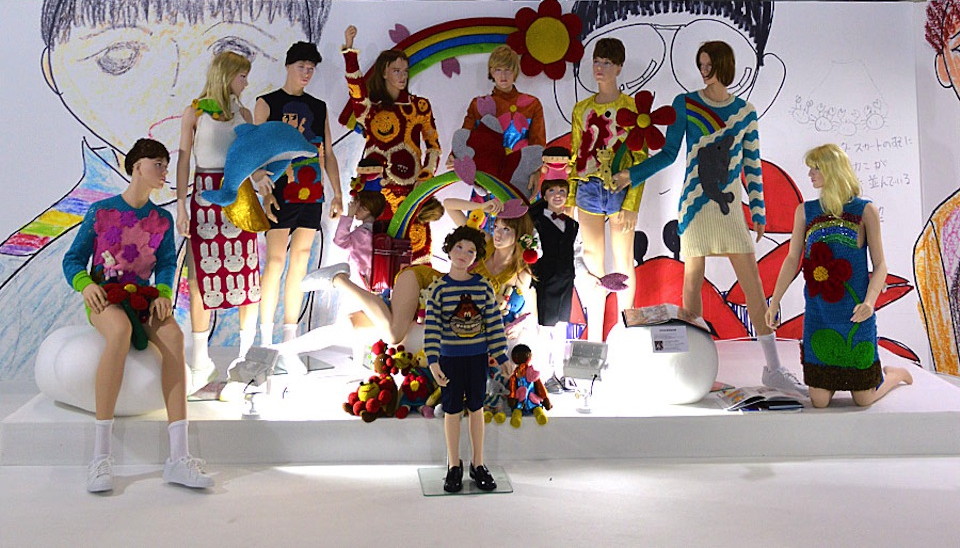
There are many successful “pairs” working together and creating things that only pairs can achieve.
In different fields: fashion, architecture, design, food…Some of those pairs are friends, couples or brothers and sisters.
Another successful pair in the fashion world is the brand Ryota Murakami. Behind the brand we find two people : Chiaki Murakami the mother and Ryota , the son. Together they are making this new creative brand and are finalist of 2014 in ITS, fashion contest held in Italy.
Ryota said that in his childhood, he wore what his mother made for him.We can easily imagine how unique it was compared to the other school kids’ wear. Gradually, Ryota feels annoying to be so special, finally he stopped going to school.He hated so much what he was wearing.
As he grew up, he found that he loved fashion. He started to study in Osaka and took a course in Kokono gakko ( the smallest fashion school directed by Mr. Yoshikazu Yamagata).
He searched his originality and found that it's based on his own experience: wearing lovely mother’s hand made garments in his childhood. Ryota invited his mother to do a fashion brand together.
The mother is the main designer and creator, the son put his mother’s lovely warm sense of kids’ handmade clothing into the real fashion world to give people this unique feeling of warmth and family touch.
“What does fashion mean?” is the eternal and philosophical question of human being. We might live with just a pair of jeans and shirts. Or maybe we cannot live without the "it items" of every season. With Ryota Murakami’s fashion, I realized that fashion is the love toward the wearer, the way to communicate who we are, the key to know how we want to relate with people.
From Tokyo by Kaori Ieyasu
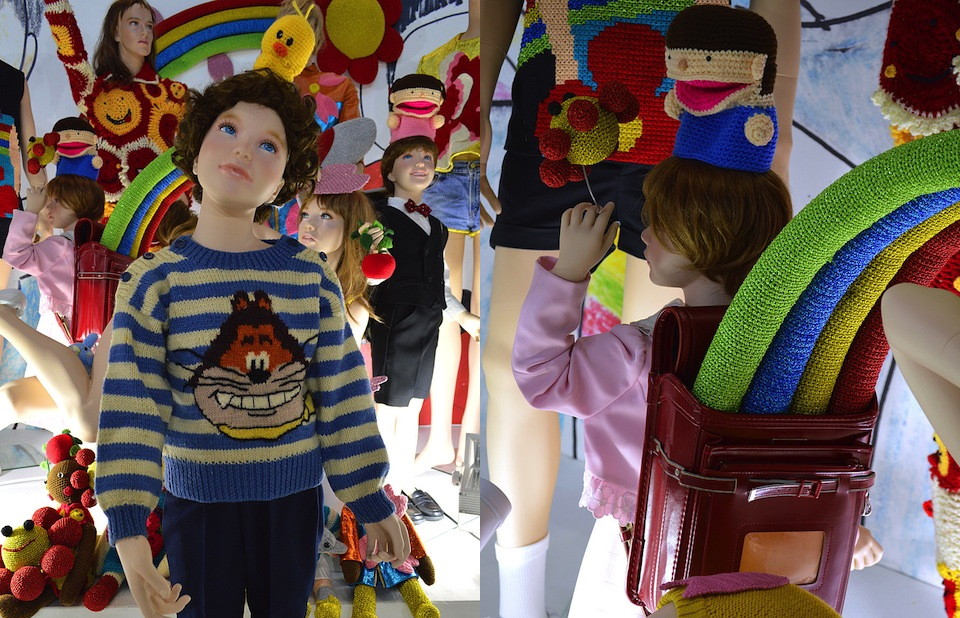
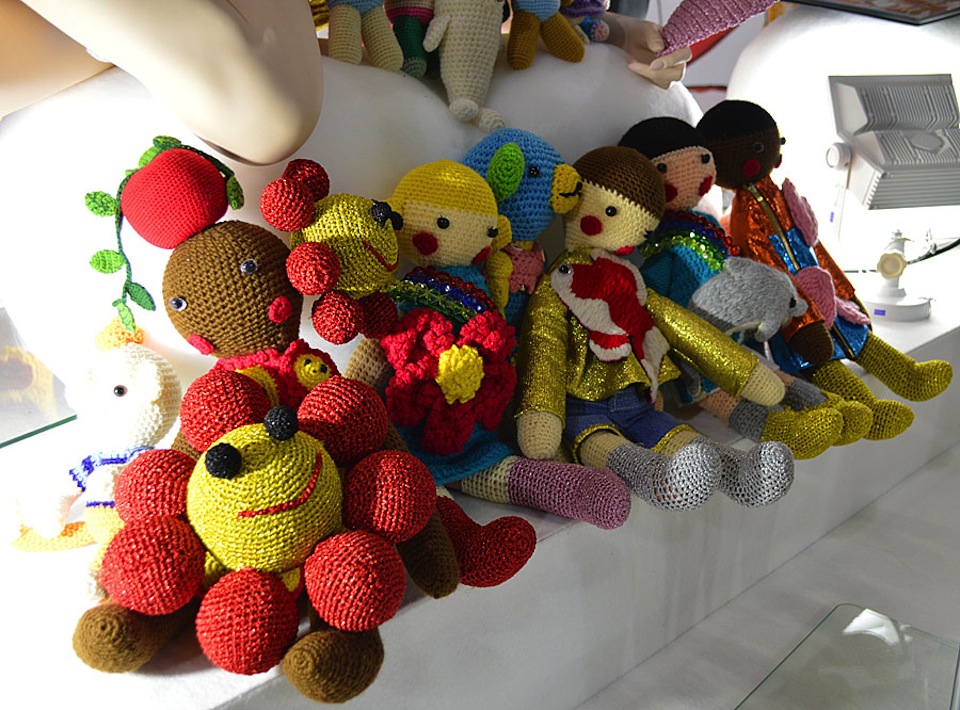
origami

In Tokyo, Omotesando just near by Shibuya is a spot where hipsters meet. A trendy place named Origami opened recently and aims to be the new place to go. Its concept is MUSIC × ART + YOU , the intention is to fuse clubbing and art together. "The idea is to create a place of opportunity for new talents to break ground in the world from Tokyo" Just like an origami can be folded into anything with creativity, this place can become anything: "It's your idea, your own "art" and your dream that shape "Origami".
'Origami' installed a great sound system, targeting on the audience and DJs who appreciate the quality of music. The club generates the latest electronic music, mainly house and techno with Japan’s leading resident DJs and top-class guest DJs from allover the world such as Francois K, Nathan Fake, Jerome Sydenham, Kenny Larkin, Quentin Harris , DJ Krush, Margaret Dygas.
The club has established a unique position in the underground music scene in Tokyo.The club, located in the center of an artistic area, displays art pieces of edgy artists, such as Takashi Murakami or Yoshitomo Nara.
At "Origami" one can enjoy simultaneously music and visual art. From Omotesando, Tokyo, to the world, a unique culture born in Japan is delivered.
Masaaki Hasegawa
origamientertainment.jp
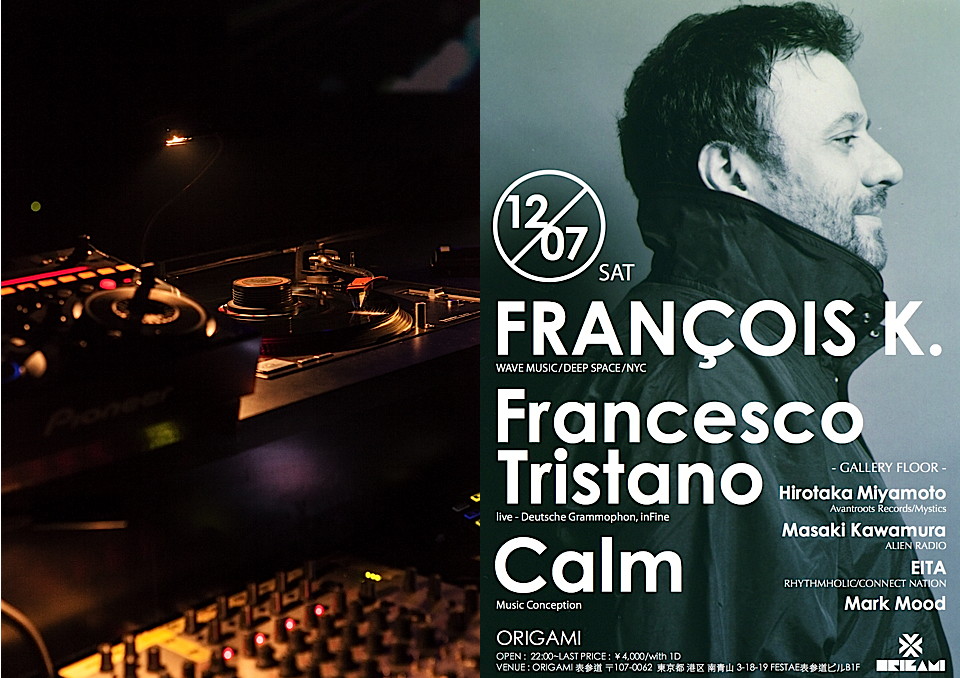
"music x art + you"
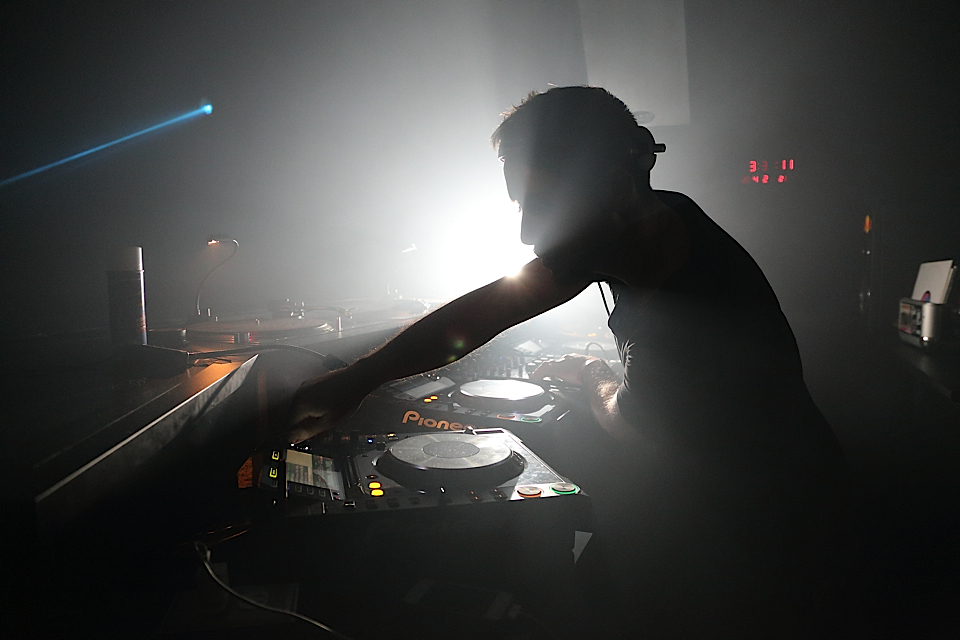
"music x art + you"
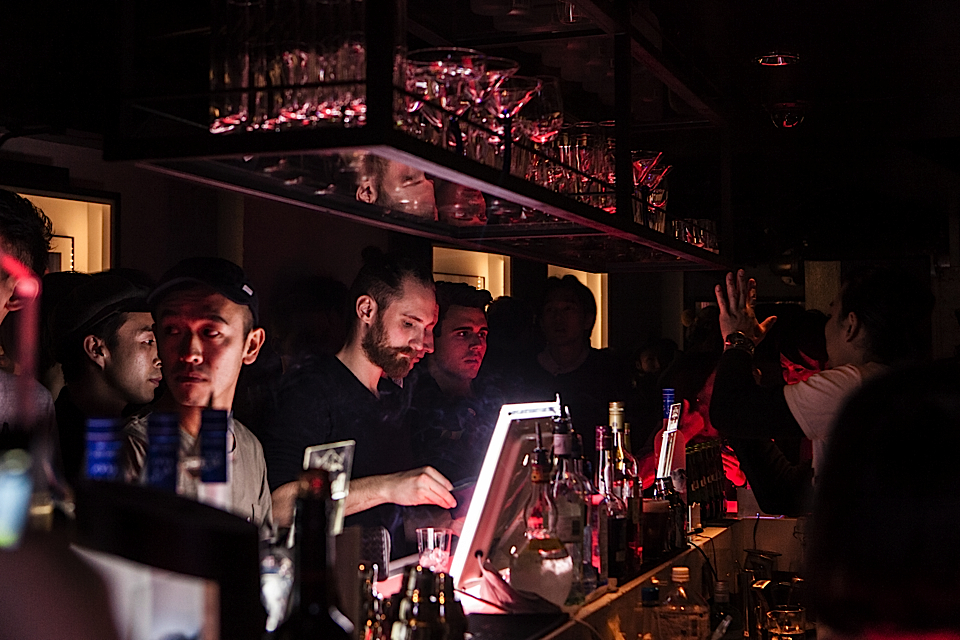
"music x art + you"

"music x art + you"
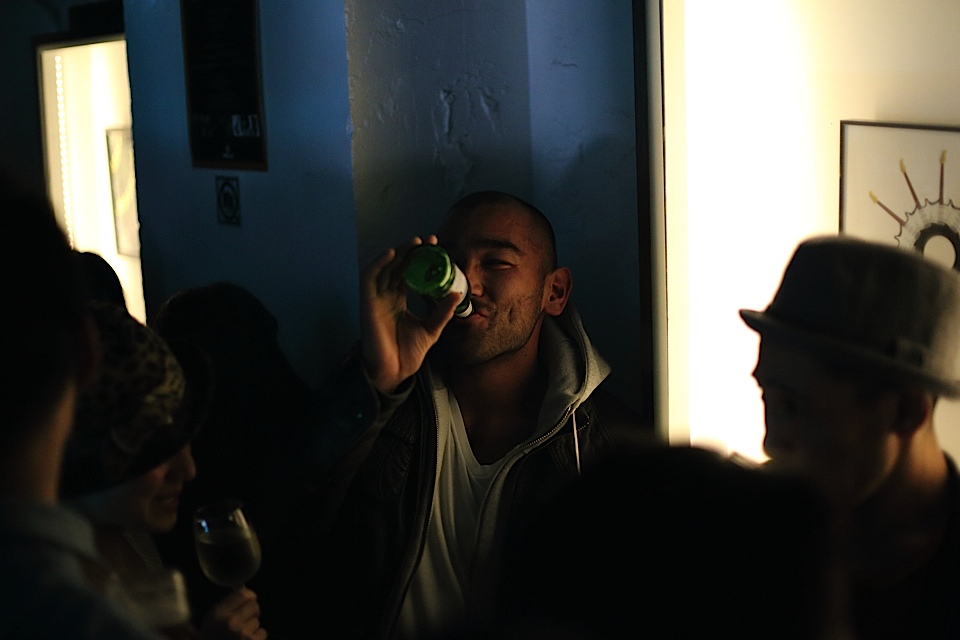
"music x art + you"
activity café

beads labo + café
The traditional “Café” has been an icon of culture, the place for artist, the place for daily life, the place for love. Ever since we’ve become nomads of 21st century with all our smart tools, the traditional “Café” has become the place for work and study. Now in Tokyo “Cafés” start to show a new face. What I call, “activity café”.
One example is in Shibuya Parco, the fashion building for teenager up to the 20’s. Located next to the beads and material shop you can find the café, “ beads labo + café”. In which people enjoy making their own beaded jewelry while drinking coffee. The café staff is on the one hand serving coffee but on the other teaching the art of bead making.
Another example is situated in Ginza, it is called “GINZARAKUGAKI café and bar by Pentel”. “RAKUGAKI” means “Scribble” in Japanese. Pentel is a stationary company popular for its markers and pens. They respect human beings expressing ability, and as we are grown up, we tend to loose the free mind to express ourselves with drawing and scribbling like child. They let people draw wherever they want in the café if wall, floor, door or table, using their pens and markers. Also all the food is related to the idea of “scribble”. We can enjoy scribbling on the dish using ketchup and sauce when we eat French fries!
In Roppongi, on the 52nd floor of the Roppongi Mori building, there is the “HOSHIZORA café” where you can enjoy thousands of stars watching the planetarium and the real stars that shine over Tokyo city through the window. They hold several seminars and events and in particular one seminar called “ light down campaign; lets’ enjoy stars with astronomer”. As the environment ministry proceeds using less than CO2 and makes people turn down lights at night, this event is to make use of this opportunity (dark Tokyo night!) and enjoy stars from top of building.
We can observe form these café movements that our needs are to gather together with a special reason , we also want to experience something familiar but yet new. With a traditional Café with a twist, somehow there is the margin to give and a feeling of freedom, even in Rakugaki Café, we can simply go and enjoy French fries and we enjoy a gin tonic in a simple way even under the planetarium. This margin might be the important keyword of today, free but some special trigger to make people gather.
For that reason, the traditional Café with a twist seems to play an important role.
From Tokyo by Kaori Ieyasu

Rakugaki Café

“HOSHIZORA café”
group sport for individual
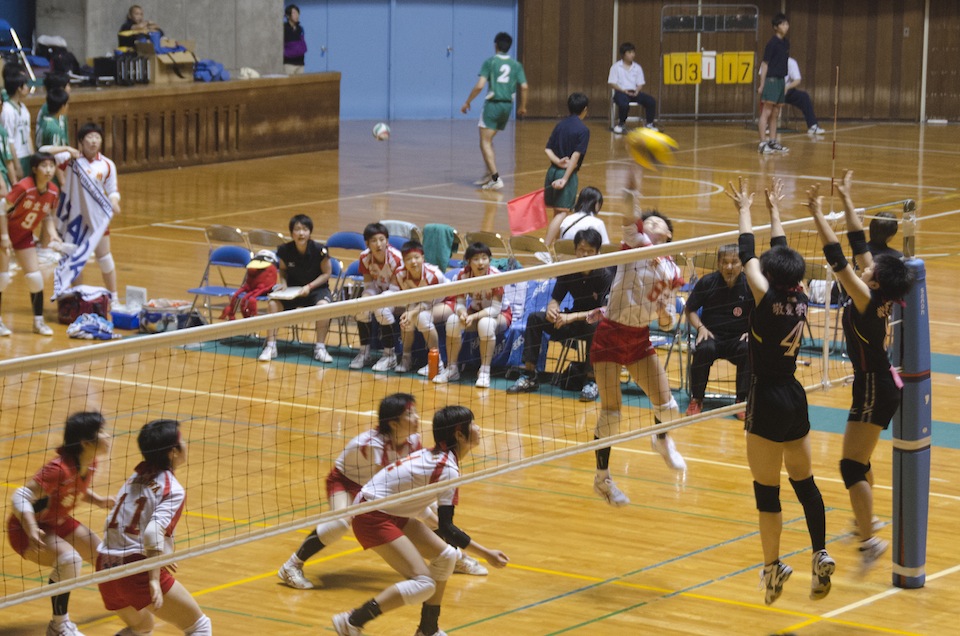
Photo by kevin butt - tHis1tRik4U Flickr Under Creative Common
Sport is an activity that is an essential and has nowadays gained more importance in our lives.
People run, do yoga, dance and swim.
But naturally, as we are all individuals, we choose a certain category of sports, in which we can participate individually.
On the other hand we are also tempted with the unique excitement of group sports, crying of joy for the victory, sharing the same strategy and score the goal, all the elements that individual sports can not provide.
Today, a new approach to the usually closely bonded sport teams has arisen.
They have adapted to the new lifestyle and opened their doors to the individual, occasional participant.
Anyone is welcome to join the group and occasionally all the members meet for the first time to practice group sports that used to be something sacred.
“ I like group sports but as I am working in a company, I can not keep up with the regular schedule of practicing it. I also don’t want to be tied to the group all the time. With this format of group sports, I can enjoy the best part of being part of a group and escape from the unpleasant parts, such as too many responsibilities.”
Since the individualism has been growing, somehow we want to gather together and mend our relationship again to connect.
Respecting our individual but connect as group, seems to be one key word of tomorrow.
From Tokyo by Kaori Ieyasu
“twin coordinate”

We have images of couple in love wearing the same outfits. We know that they can have similar taste and like the same brand or style. Something also familiar is small kids like sisters and brothers wearing the same outfits in different sizes.
What we saw recently in Tokyo is friends in matching outfits. Two girls wearing exactly the same outfits like twins or lovers. The reason is that it's simply fun to do it and also they think “twin coordinate” takes more attention from others. To do“twin coordinate”, they use SMS to share what they will wear before going out.
Fashion used to be the identity of each uniqueness, somehow it became also the language of the group or the area we belong to; now it seems that fashion is more about the costume itself.
From Tokyo by Kaori Ieyasu
fast & healthy or slow & fat ?
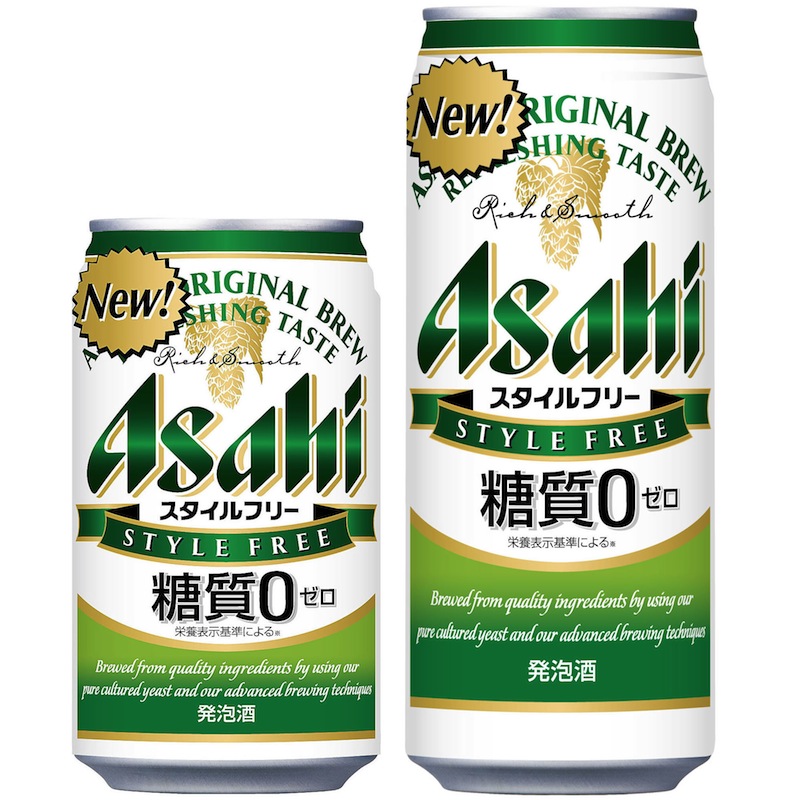
Many foods and beverages nowadays are heading toward not to only be organic, healthy and low calorie, but also effective to our body like medicine. Even Pepsi became a healthy drink to decompose the extra fat in our meal like oolong tea for oily Chinese dishes. Beer is promising 0 calorie and 0 fat. Surprisingly, we can get these “healthy foods and beverages” at the convenience store, 24 hours, very easily and in a fast way.
The distinction between healthy food and unhealthy food becomes unclear because we used to categorize healthy food as slow, and fast as opposite. I have already mentioned that we can get healthy approached foods and beverages in a fast way. We recently witness in Tokyo a long long line in front of a pop corn store serving also very rich high calorie pancake shop with full of creams and sugar on it. Sometimes people wait under the rain to get caramelized popcorn for 2 hours or more, and people try to experience Hawaiian style creamy and big pancake breakfast from early morning and they finally can eat them around lunch time.
Are we heading toward to a health conscious food life? I am not trying to say that popcorn and pancake boom is good or bad, but I found it is a very interesting moment: we see that the fast, slow, healthy and unhealthy categories have an unclear status.
Now it is time to re-think and re-construct what is healthy and what is not, what is fast and what is slow and so on. From this fast healthy and slow fat movement, we start to think what is really healthy for our body and soul. It is still true that we need to be conscious about the use of agricultural chemicals and about the way we feed cows and pigs. To keep fit, we need to think of the calorie and nutrition smart way.
At the same time, we cannot forget to nourish our soul and sense and maybe sometimes it is only done by something we already categorized as “ not healthy” food. I witness 3 girls surrounding a big creamy pancake together and cut in pieces and eat with big smile. I can imagine the joy when you bring back the big popcorn box with crispy and sweet smell. Suppose we take healthy things in fast and daily to allow ourselves to enjoy not healthy without any hesitation?
Since human being is a very wise animal, it is natural to balance between opposite matters so that this antagonism can be not too far from the truth? Same things can be said with other industries, fashion, architecture, design…. Anyway, we want to nourish our body and soul at the same time, and for that, what we need to think is to face our humanity in a new way.
Kaori Ieyasu
boro - the fabric of life

Samantha Allan is a UK-based artist, curator and co-founder of The Shop Floor Project, an award-winning space which works with contemporary designer/makers and museums to develop collections, exhibitions and workshops.
Mottainai and boro boro are two terms in Japanese philosophy which seem to perfectly contextualise Boro: The Fabric of Life, exhibited at Domaine de Boisbuchet. Mottainai is a term which conveys a deep sense of regret concerning waste whilst the phrase boro boro celebrates the beauty in something frayed, decaying or repaired and provides the exhibition with its title.
Boro: The Fabric of Life contains fifty fragile pieces of endlessly repaired and patched futon covers, kimonos, work garments, and other household textiles which were created by Japanese farmers between 1850 and 1950 using leftover, indigo dyed cotton.
The majority of the textiles are sourced from the collection of New York based gallerist Stephen Szczepanek who also co-curated the exhibition. His gallery, Sri Threads, is an ever changing collection of astonishingly repaired antique Japanese folk textiles.
There could be a tendency to romanticise these textiles yet, as Szczepanek explains, this art of repair did not begin as an abstract philosophy but was born of necessity: “Boro textiles were the domain of the ordinary man and represented a collective, impoverished past.
They were largely forgotten after the mid-twentieth century when Japan’s society shifted towards mass-scale modernization and urbanization. However, they are the tangible embodiment of a cultural legacy which has only recently been accorded a formal name and has received critical consideration”.
These textiles may have their origins in austerity and utilitarian design but the sophistication of the repeated repair, often by several successive generations, means each piece is completely unique and as such gives the fabric a sculptural and considered presence.
It may seem strange to see these frail pieces of Japan’s rural history within the context of a 19th century French chateaux, yet each piece of fabric is sparsely and elegantly displayed throughout the exhibition’s empty and fragile rooms. The walls, which reveal years of historical repairs, are preserved and celebrated just like the boro boro textiles that Boisbuchet is playing host to.
Samantha Allan




mitate
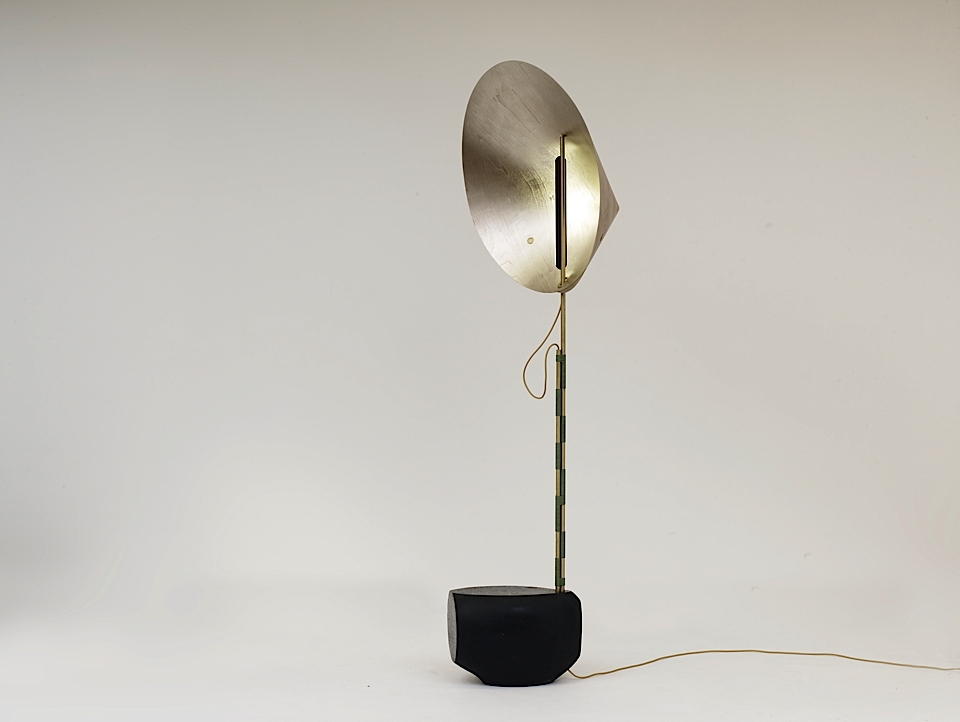
Yuu Mirror Lamp photo by Fabrice Gousset
The new lighting collection of Studio Wieki Somers (Rotterdam) brings the pleasure of its evidence and oddity. As we move closer to the collection, the glowing figures become familiar—a familiarity in which we recognize the other. This sensation is not conjured by our everyday lives or background, but by our imagination and fascination for the otherness of a foreign culture, which seduces us as well as subdues our judgment. It is not the easiest form of seduction.
Larger than us, the seven floor lamps united under the name ‘Mitate’ fill and protect the gallery space, acting as flamboyant samurais. In Japanese, ‘mitate’ signifies the perception of an object in a non-habitual way, to contemplate an object as if it were something else in order to renew its meaning and experience. An essential part of Japanese culture, the ‘mitate’ principal was a cornerstone of ikebana art. In Western culture, Alfred Stieglitz taught us how to look at clouds with his photographic series Equivalents (1922–1935). Equally, Robert Fillou (known for his travels in Japan) stated, “Whatever you think, think about something else. Whatever you do, do something else.” It is tempting to add in this context: “Whatever you design, design something else.”
Since 2003, Studio Wieki Somers has personalized this philosophy in order to invent a breathtaking design practice, reworking the concept of ‘magic realism’. Often inspired by ancient or mundane customs, its creativity imbues fantasy into the most common objects, promoting an enchanted perception of our everyday life. A bathtub becomes a small boat (Bathboat, 2005); a teapot is concealed by a rat’s skull (High Tea Pot, 2003); a coat rack in a Museum becomes an interactive merry-go-round (Merry-go-round Coat Rack, Boijmans van Beuningen Museum, Rotterdam, 2009). Its previous lighting creations are wrapped in the same spirit: the ceiling light Bufferlamp (2002) emits the golden blaze of a harbor at twilight; the iconic Bellflower (2007) is weaved from only one strand of carbon and glass fiber; the frosty pieces from the Frozen in Time collection (2010) are instantly refreshing.
With Mitate, a game is played between the simplicity of the lamps and the sophistication of their Japanese forms, inspired by trips to Japan in 2011 and 2012. From this travel and through research of local craft knowledge, Studio Wieki Somers collected sensations, materials and images.
For instance: the enigmatic XVIth Century Samurai flags whose designs identified clans and demonstrated their unique powers, the production and use of which was a highly ritualized affair (Jin, Fabric Lamp). Wieki Somers writes, “We wanted to create a contemporary equivalent of sixteenth-century Samurai flags translated into ‘light poles’ – a family of lamps.” Other inspirations for the Mitate collection include the fabric used by geishas to protect the light color of their skin from the harshness of the sun (Chuugi, Black Hole Lamp); the stone gardens re-enacting for the pleasure of the eyes the intensity of the world (Gi, Cord Lamp); the traditional doll who seems to be juggling with her hats (Rei, Shields Lamp).
Shown together and reflecting off another, each of these lamps possesses its own identity, displaying its specific surface, shape and chromatic colors while proposing a unique combination of technology and artisanal craft. What’s more, each of these light totems illustrates one of the seven principles of the bushido samurai code of honor, from which they are named*. The materials of each lamp are chosen with care. Whether reflective or mirroring, absorbing or translucent, each material creates a distinct lighting style. The lamps are created from two different kinds of bases. The first is a base resembling a traditional tokonoma altar, creating space for the organization of different objects; the second is made from polyester concrete with its edges carefully sliced, revealing the texture of the stone.
But let’s not dwell on the matter any longer. The mitate effect is lurking. “Whatever you read, read something else.”
Clément Dirié
*Gi, the right decision; Yuu, bravery; Jin, compassion; Rei, the right action; Makoto, truth; Meiyo, honor; Chuugi, devotion.
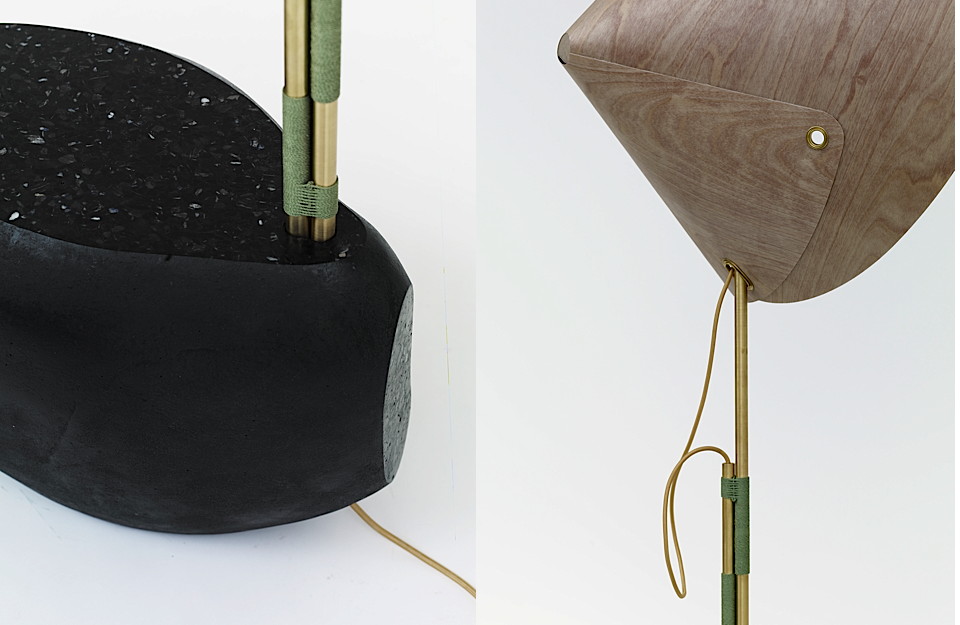
Yuu Mirror details photos by Fabrice Gousset
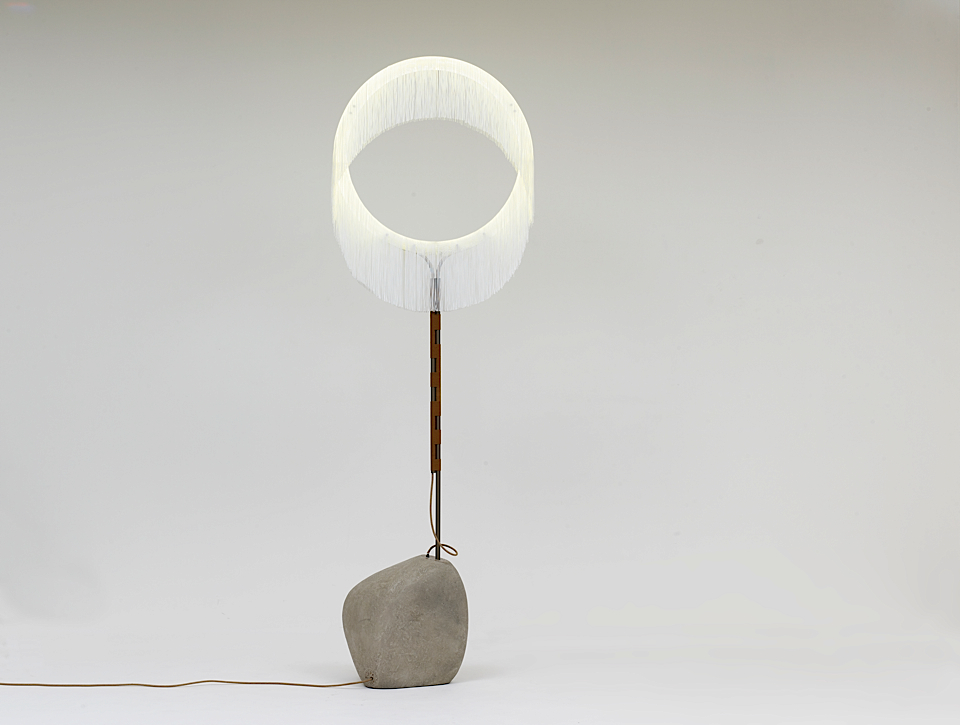
Gi Cord Lamp photo by Fabrice Gousset
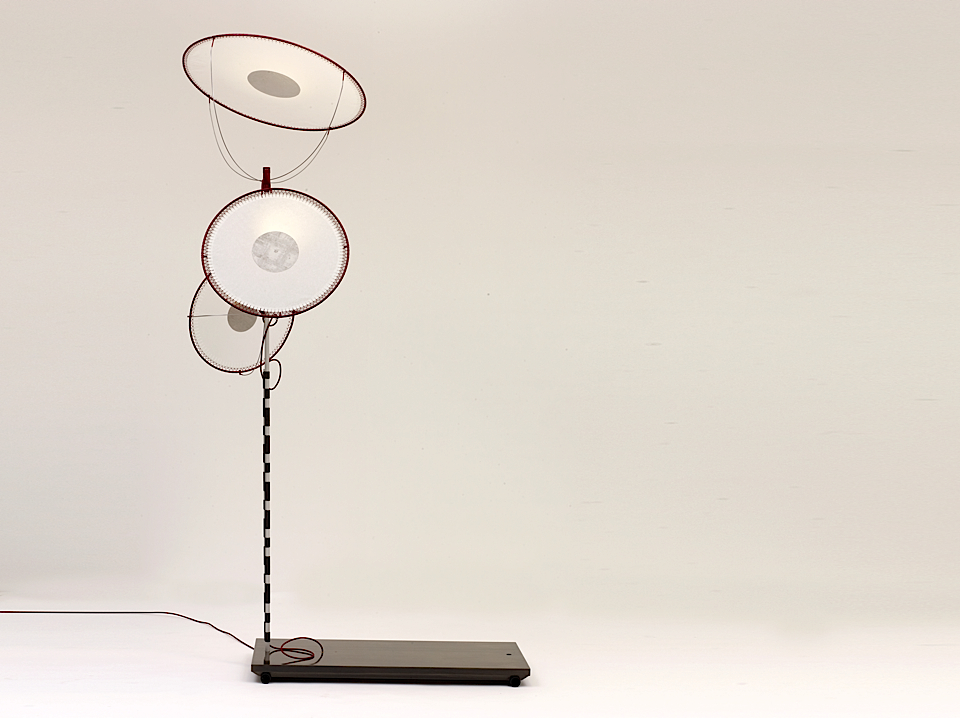
Rei Shields Lamp photo Fabrice Gousset
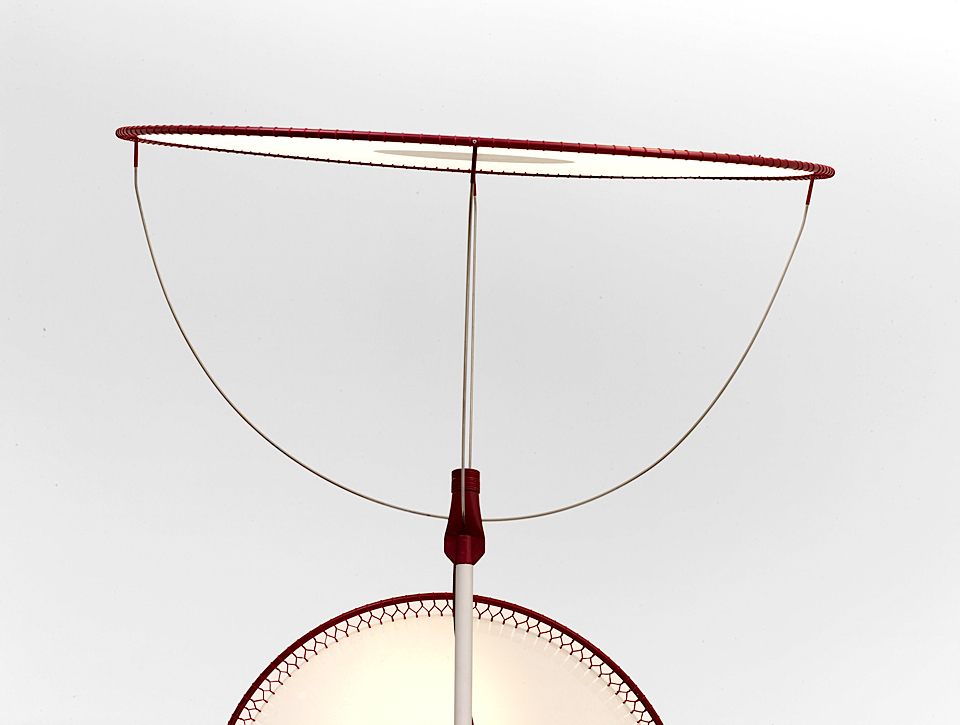
Rei Shields Lamp details photo by Fabrice Gousset
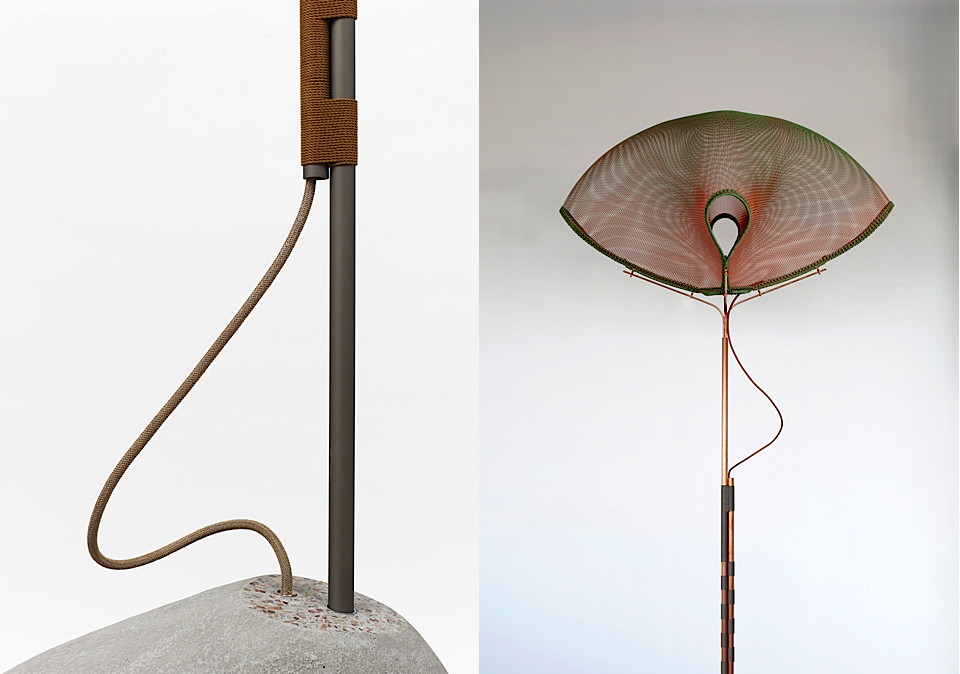
Left : Gi Cord detail. Right: Meiyo Mesh Lamp. Photos by Fabrice Gousset
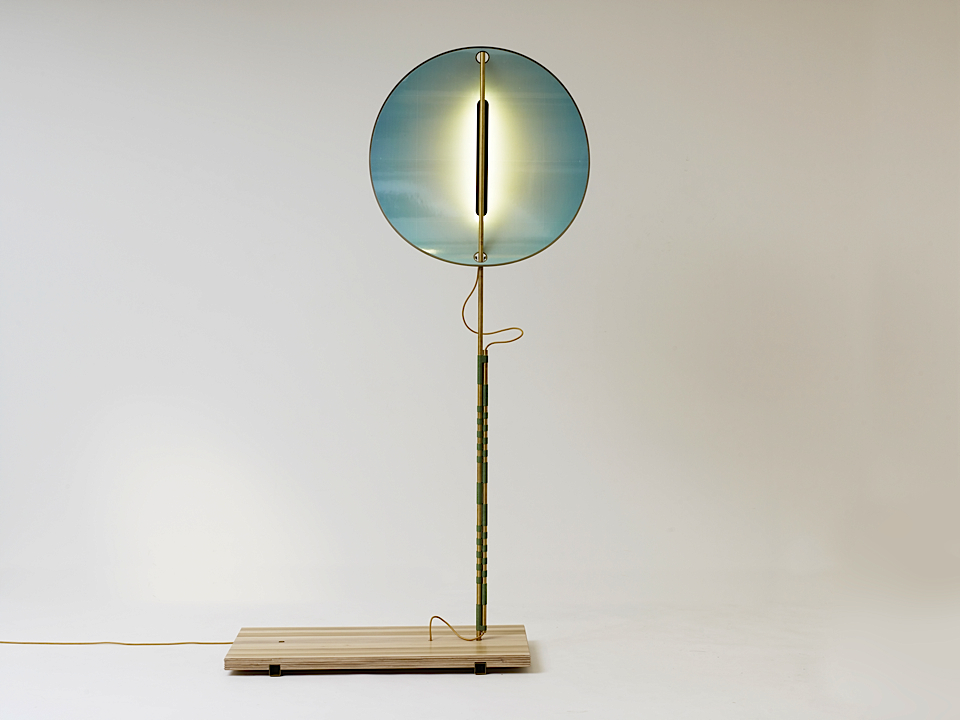
Makoto Reflection Lamp photo by Fabrice Gousset
your fashion!
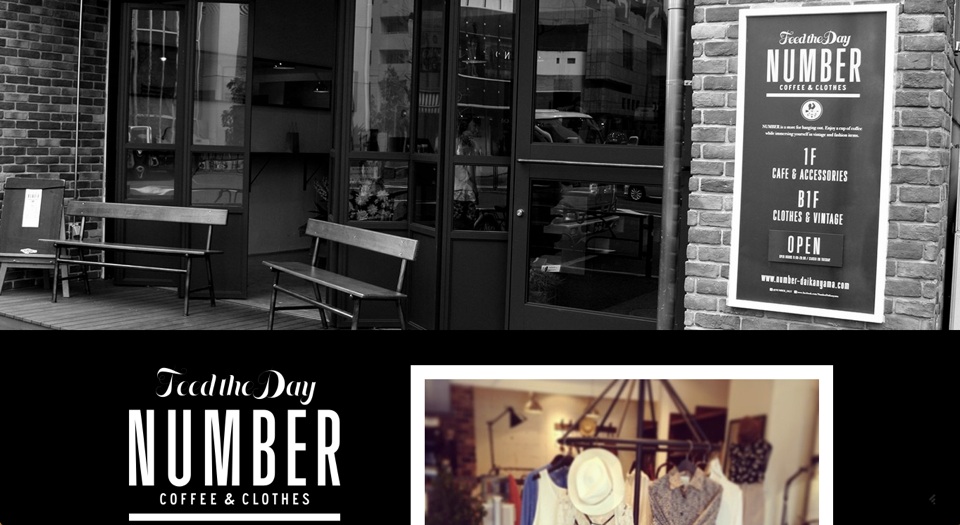
What does “fashion” mean? Of course, it means garment. Fashion is the tool to express ourselves. It also should be synonymous of culture.
Since several years, it seems that “fashion “ was only translate in reasonable daily products and has lost its own way and strong charm to grab our soul.This is why we started to think: “ can we make things ourselves?” Some select shops already propose “semi- order” bags and a lot of creative people start knitting.
In Tokyo, several “order-made” style shops open recently. An interesting one is in Daikan-yama area. It’s a coffee shop called “number”. Here, you can order a cup of coffee and at the same time, your own dress & shirts! There are 14 styles of patterns and more than 60 kinds of fabrics so that you can pick up your own style and fabric to make an original garment.
For boys, we now have “Freemans sporting club-Tokyo” from N.Y.There you can order your own suits done by a skillful artisan.
Recently, a more surprising style was introduced by a fashion brand named «Theatre products». Established in 2001 it proposes theatrical and happy garments for every day life. Now on their website you can select a style and a fabric pattern. Your order will be printed on the fabric you choose and will be delivered to your door. You will be able to cut out the pieces and make your own “Theatre products dress”.
«Theatre products» has a quite strong perspective and a real fashion world; this brand has been proposing interesting garments every season.
They try to involve consumers to enjoy “fashion” again. “Theatre Yours” is at the same time your own dress and a Theatre Product' garment!
Fashion seems to be interesting and back in culture here in Tokyo.
Kaori Ieyasu
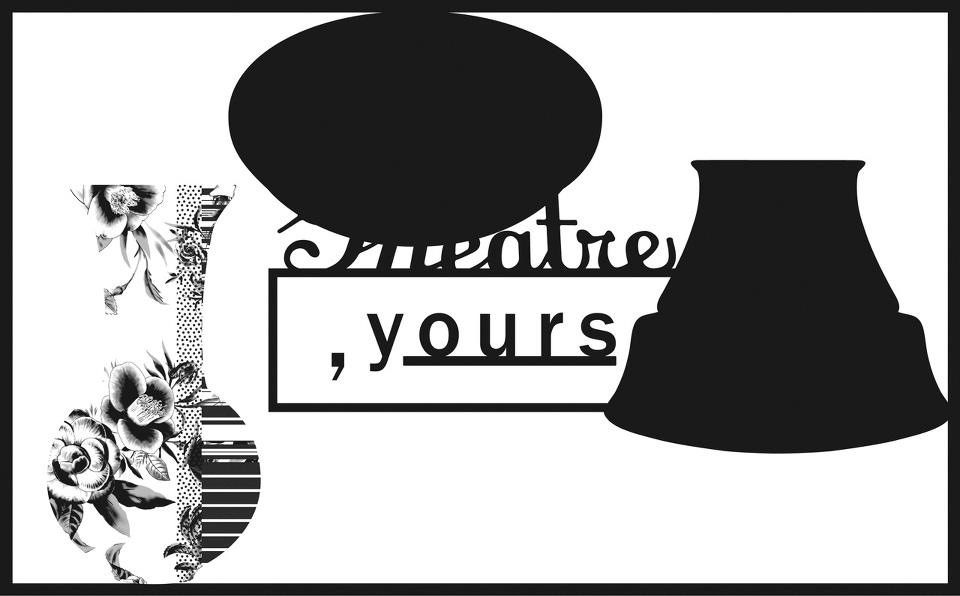
two visions of women
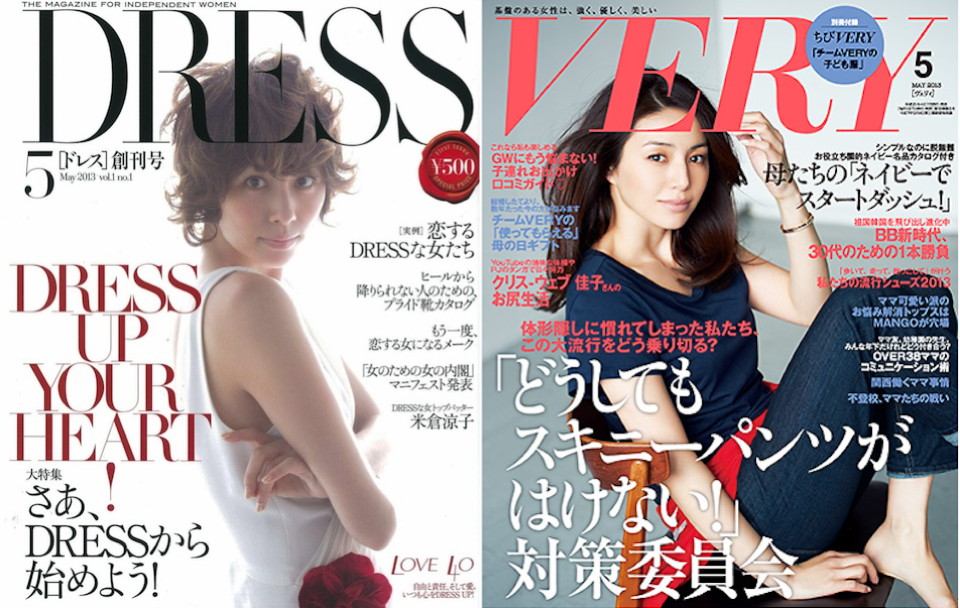
It is about a woman around 30 to 40 years old. As I look over the shelf in the book store, especially fashion magazine, it's obvious that there are two visions there.The Japanese version of foreign magazine like Vogue and Elle. But, two magazines are more interesting: one is “Very “and the other is “Dress”. Both magazines target a woman around 30 to 40 years old, who is wealthy enough to afford a Chanel bag but not super rich still.Those two magazines have totally different approach.
"Very" targets a married women managing kids and a professional career at the same time.This magazine’s catch copy is “women with certain background (family) are specially beautiful”. Naturally, the issue is mixed with fashion for the work and fashion for mama, special column about job and economy at the same time deep discussion about pregnancy or best kindergarten list for kids. The highest position of this hierarchy is the women with kids and career, so that the money issue is about how to start your own company.
On the other hand, the new magazine called “Dress” targets a single women who have career and enough money to use for herself. Her partner/ boyfriend is 8 to 10 years younger than her but she also enjoys being alone. She is still interested in marriage but she doesn't find it really necessary. Its catch copy is “ the magazine for independent women”.The fashion issue is very "dressed up", not any relaxing denim or jersey, only dresses and dresses. Special column about a bar where you can enjoy cigar and anti-aging cosmetics.The money issue is about how much we should save before retirement.
What I found very interesting in those two magazines is a high-heel shoes issue. Both magazines are treating the same topic during the same month: “ you can run with these high- heel shoes!”. But in "Dress", the situation is in the office and in "Very", it is in the park with kids. Same brand, same shoes, same age target but avery different motivation for shopping.
These magazines sell pretty well. As the young generation is less interested in fashion or they simply cannot afford it or they take information not from magazines but from the web. I see that the main target for fashion magazines is now around 30-40 years. There are two totally different point of “happiness”, “ the goal of women’ life”.
For the season of 2013-14 AW "SHOPPING", Lidewij Edelkoort has forecasted the necessity of restructuring department store and targeting consumers ( we cannot categorize women like “young”, “adult” and so on). Today, after a long term economy crisis and disasters shock, we are more precise with shopping and we care more for our happiness.“What we need”, “how we want to be” become more and more specific.
Then, I start to think, what will be next? Two types of women, single or family. Then what? Yes, we can “forecast” other new categories!
From Tokyo, Kaori Ieyasu
a new season for daily products
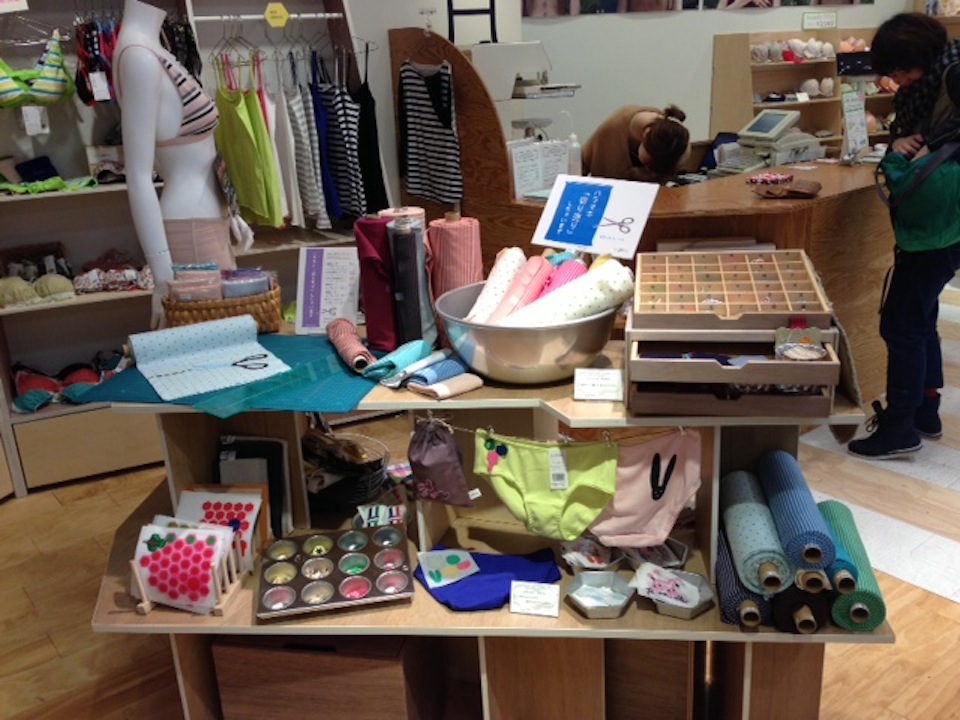
photo by kaori ieyasu
What kind of keywords and images come to your mind if I ask you about underwear and stationary ? With underwear: sexy, close to skin, personal, hidden, lace, color, intimate relationship, keep the body stylish and so on...With stationary: pen and paper, something for work and study, on the desk, office use ...
Recently, two new projects made us open our eyes again toward these ordinary daily product.
One is by "une nana cool" directed by Wacoal, one of the top and creative underwear company which has been dealing with human body and its beauty. Wacoal is THE company with very innovative use of new material, new vision toward the beauty of women’s body. With their private brand called "une nana Coeur and Lunch", they propose a new vision toward underwear. It is far from stereotype sexy approach. It is closer to art and fashion. For example, the product called “Pantsnpa” invites us to create our own under pants. Using stretch fabric which can be cut easily by scissors and without worrying about fray, they propose the customer to cut out their own pants with the comfortable length. Colorful fabric invite our intuition to what we want to put on. We are excited like kids to “cut out” our underwear with scissors. The result is a personal comfort of under pants with your own length, a wonderful fit and a smooth surface which made us feel luxury.
About stationary, surprisingly, even after we note everything in our smart phones nowadays, stationary and paper products become more important much more than before. We feel like having stationary on our desk, in our bag and want to write down with pen.
We start to search for the “best design” in stationary, which we still want to keep even if we can do everything with our iPhone. Tsutaya Book Store is the biggest and the most interesting bookstore opened last year in the center of Daikanyama. We realize again the fun to read books and the excitement to be in a book store. With this very challenging shop, we can see again the joy of “stationary”. They invite designers, artists, architects and material companies to create together the new stationary.
Tsutaya Book Store don’t design the stationary but they see the material again with a new vision and what we can do and want to do with the “stationary of 21st century”.
When we look around us in the town, don’t you feel sometimes we have enough? Same style of fashion, same things, same and same… Since only a slight different color or design is called “new”, we lost our appetite toward shopping. But when I cut out my own underwear with scissors and when I think of a new stationary, suddenly, I feel the excitement and start to imagine a life with these stuffs, which will open our senses to the daily life and will make us happy to use them and be creative.
Something ordinary but new will lead our life soon.
Kaori Ieyasu
discover what we still don’t know
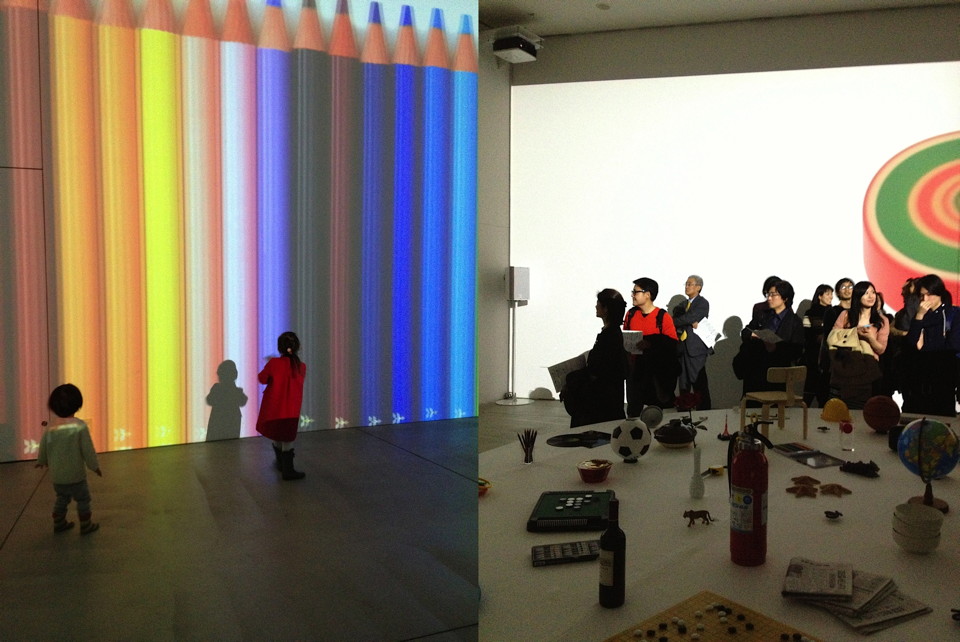
design A - photos kaori ieyasu
Under the flood of information nowadays, it is hard to say “we don’t know”. We can search for whatever we like to know. Virtual comes closer to reality and we can “experience” a lot in virtual way, sometimes it is even more real than reality itself. But, we come back and say we still want to know and we still want to see things in real. We want to use our hands.
“DESIGN A” is a TV program from NHK education, which supplies high quality program toward kids, inviting various top artists, designers, scientists, photographers, musicians and actors to create wonderful short program. “DESIGN A” is one of these kids education program that help them to understand the meaning of design around us. Mr Taku Sato (graphic designer), Mr Keigo Oyamada (musician) and Mr Keigo Nakamura (interface designer) are responsible of this program.
In the program, they try to see design in different ways.
For example in “dissolve it!” they break down one very simple thing into pieces.
Many people are fans of this wonderful program, from kids to adult. Since 7th February, we can see and experience this TV program in a real space as an exhibition in 21_21 design site.
With the participation of designers and artists, this exhibition offers the chance to touch the meaning of design, it is real fun to see things in a different way even it is just the ordinary daily stuff. You can play with music and movie reacting together with your body movements, you can learn how to form a balloon with just single pieces of paper, you can sketch a penguin with others visitors by drawing on iPad and posting your “point of view”.
You realize how one thing can bee seen in different ways.
Since design is now a commercial "tool" use to better sell any kind of products from “design hotel” to” design apartment”, we started to feel suspicious about design. But here we can realize the real meaning of design. The simple pure joy to be creative, to see things differently and to find ourselves. That is Design!
Kaori Iyeasu
the smallest fashion school
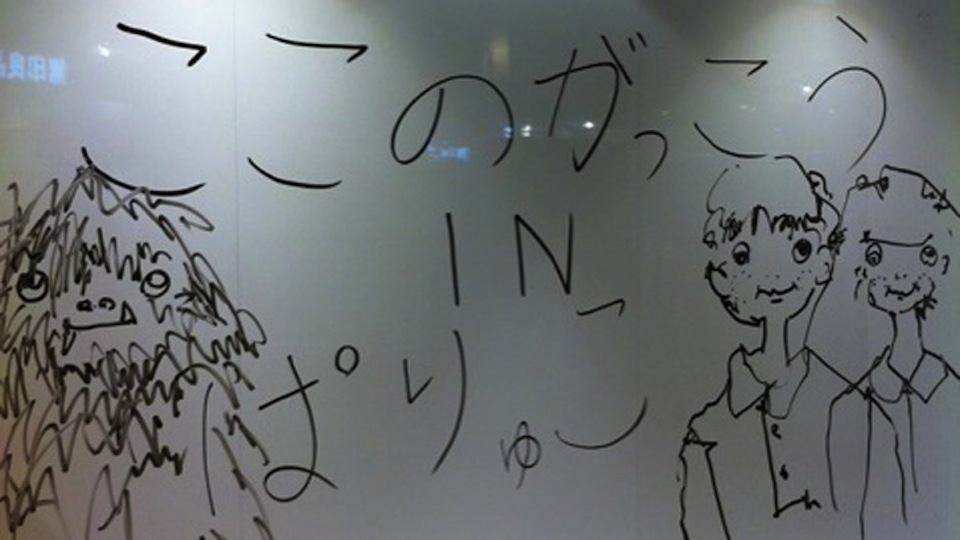
Shibuya is the popular place for young fashion in Tokyo.
Parco is a fashion store in the center of Shibuya and it has been a place to be visited for fashion research and also simply for shopping. Recently, this store has been renovated and on 4th floor, where there is a new space called Pyaruko.
From Monday to Friday this space is used as a select shop for up and coming designers, and here you can find something special which you cannot find in other shops.On Sunday, this space becomes school, and I believe it is the smallest fashion school in Japan. This school’s name is "Kokono Gakko", it has 2 meanings: “the place for school” and also “ the school for each one of us.”
This school is hosted by the fashion brand Written Afterwards and its designer, Yoshikazu Yamagata, who has been teaching young talents in other fashion schools as a guest teacher but he made his own school to share his idea toward fashion. He believes the aim of fashion is the communication tool to give the meaning of education, society, and environment. He and his colleagues, friends, and designers give an idea about how to make a portfolio, and how to realize through design an idea.
Amazingly Kokono Gakko achieved remarkable results only after few years of its foundation. Last year the biggest number of finalist of ITS ( biggest fashion contest in Europe supported by Diesel, organized in Torieste Italy) selected participants from this smallest school. 3 Japanese students were selected, 1 from Royal College of Art and the other 2 students from Kokono Gakko. Previously the school had been held in Taito-ku Designers’ village. However, with the new start of Pyaruko in Shibuya, Kokono Gakko seems to step into the next stage.
What is interesting is Pyaruko closes its shop function on weekend, the most salable moment for shops and opens the school. But as I see the visitors reaction, I understand its meaning. We “spied” the birth moment of fashion there and can imagine clearly, in a near future, we can buy these exciting “talents” in the shop. As Lidewij Edelkoort mentioned about new meaning of "Shopping" in her trend forecasting 2012-13 AW season, we see many department store's renovation and beginning anew.
What Parco did is to touch the real meaning about “dealing with fashion” and involve customers from the birth of fashion to shopping itself.
Kaori Ieyasu
positive thinking
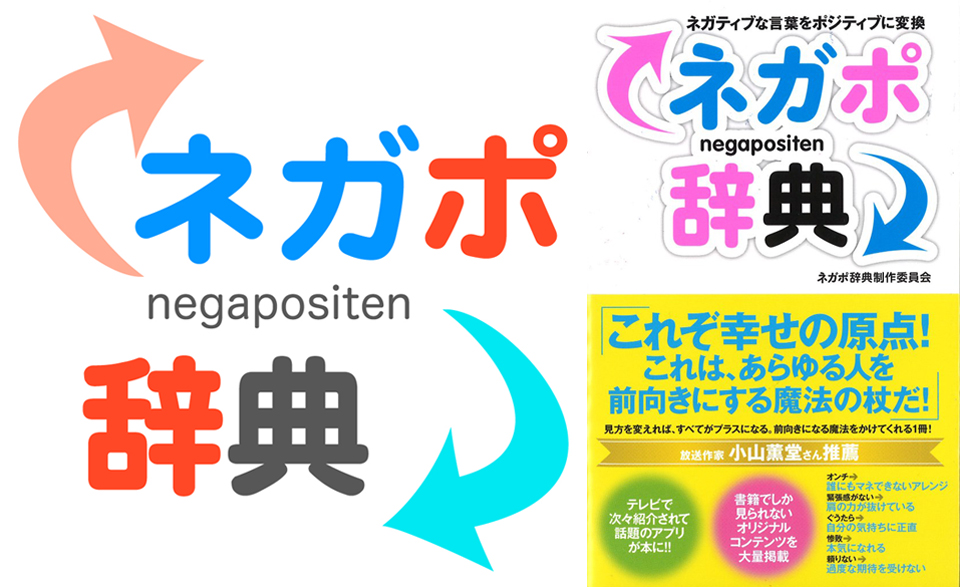
One of the significant and singular talents that we have as human beings is positive thinking. Even under difficult circumstances, we try to recover from it, and try to make it better using all knowledge and experiences.
Recently, one application of positive thinking called “nega-po apli” (negative-positive application) becomes popular in Japan. This application has been designed by 3 high school students and won the 3rd prize in the “design competition for all high school students” this year and now it is released as free download dictionary application and also published as a paper dictionary.
What is interesting is that they have not “designed” exactly opposite meaning of a negative word.
For example, if you want to mention someone who is “gloomy”, this dictionary changes this negative word into “settled”.
“he is gloomy”= negative
“he is settled”= positive
“this shop has bad taste, doesn’t it?”= negative
“this shop has a unique world!”= positive
The negative words cause conflict and also make people’s feeling down but we tend to use negative words. This application, however tries to let people stop the negative way of thinking and make us realize how we can think positively.
We see negative news and report on TV and we feel like staying a dark tunnel forever but we come closer to the end and start to see the new light and at the same time, we definitely have learned how we can create the “positive”.
Kaori Ieyasu
kamado-san

photo courtesy of toiro
The "Kamado-san" is a donabe rice cooker originating from Iga, Japan. The ceramics from this region, among Japan's most highly regarded, date back to the 7th Century. It is said that clay pots make food taste better, and with the "Kamado-san" it is easy to see why.
The clay used to make Iga-yaki ceramics is sourced directly from the region, which used to sit at the bottom of a prehistoric lake called Biwa Lake. The 4 million old earth layers make for a porous clay which "breathes" as it cooks. A donabe is placed directly over an open flame, and slow cooks as the clay absorbs heat. The heat is retained even after the flame is distinguished, keeping food hot until it is ready to be served. While the ceramics are practical, they are also beautiful.
Naoko Moore, a Tokyo native, is passionate for the "Kamado-san" and Iga-yaki ceramics. In addition to being the US representative for Nagatani-en, the leading producer of Iga-yaki potteries, Naoko also runs a blog devoted to her love of the cooking method.
Upon a recent trip to the Iga region, Naoko had the opportunity visit the Nagatani family. As she writes, Mr. Yuki Nagatani is passionate about good food, believing that it gives happiness and connects people.
We also wish to share the "Kamado-san" and how to eat from the earth to the table. Enjoy!
Text by Ryan Moritz

photo courtesy of toiro

photo courtesy of toiro
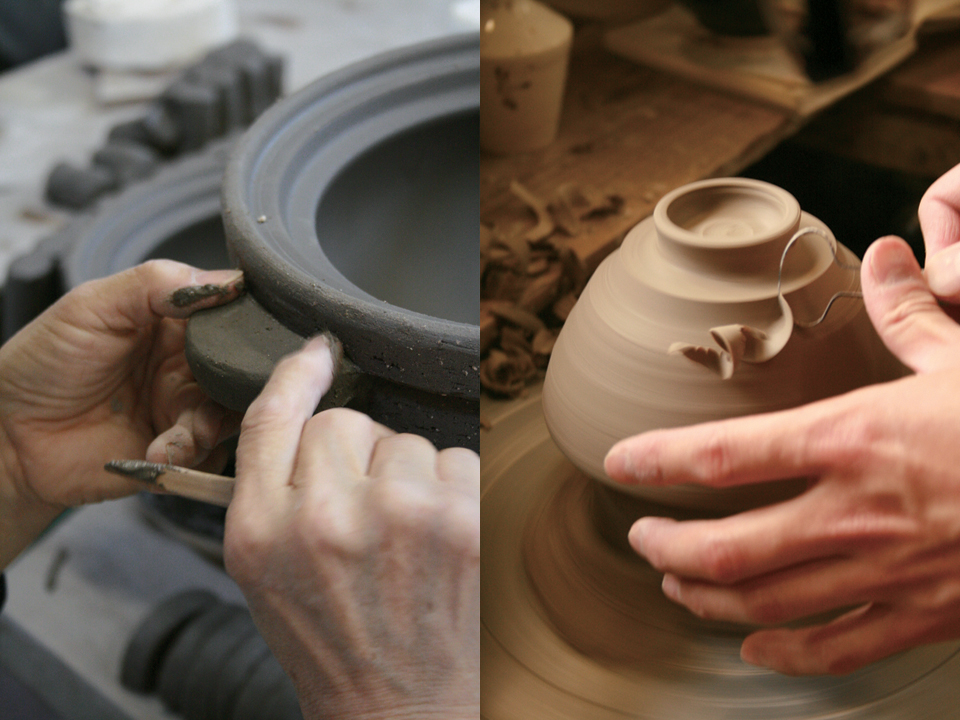
photos courtesy of toiro
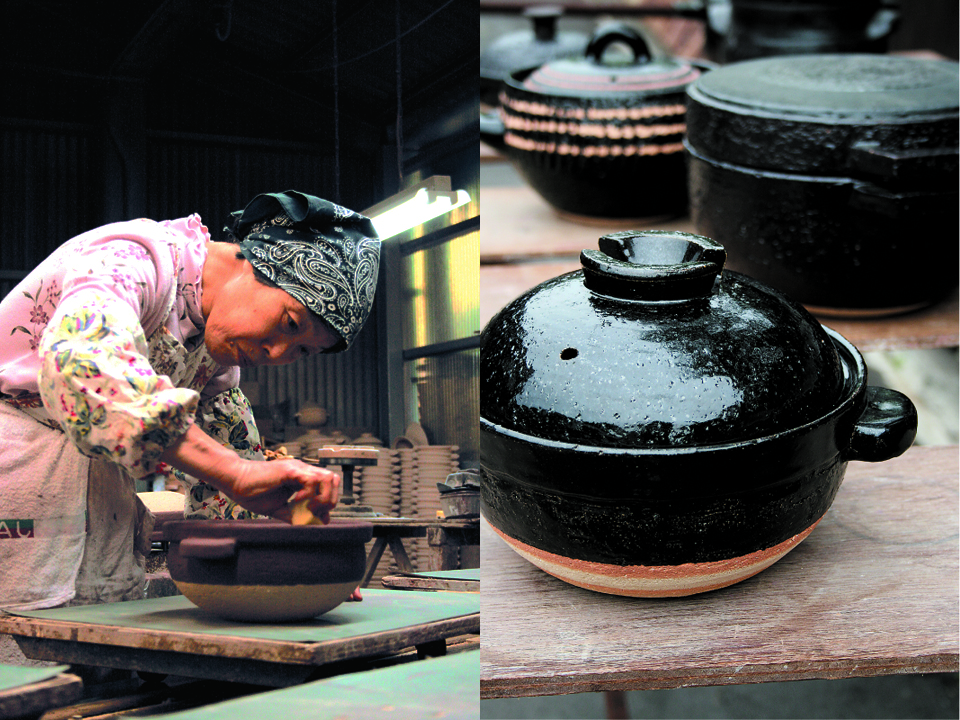
photos courtesy of toiro

photo courtesy of toiro
fashion & design week #Tokyo - october 2012

photo emmanuelle linard
Lifestyles
Young Tokyoites have a passion for yesteryear's lifestyles. The Batoma design/gift fair taking place at the Laforet Mall in the Harajuku District hosts several designer booths exhibiting curiosities in a European 19th century style, with bones, patina metal racks and wooden cupboards.
Vintage stores in Harajuku sell antique dolls and sportswear coats and dresses transformed with the addition of old fashioned lace and cut ribbons. A confirmation of the romantic trend and memorabilia.
At the traditional tea house Baishinka in the Yakumo district, two young fashionable Japanese girls are taking styled photographs with a vintage camera.
In a contemporary world where every photo, text, soundtrack, any piece of information can be manipulated, doubt reigns; therefore a desire for truth entices young people to revive the old days and obsolete mechanical objects, with antique cameras, old-fashioned typewriters, or old telephones.
As in the Sundance festival award winner movie 2010 Obselidia, a passion for encyclopedia, collectors and explorers is noticed amongst a young Japanese crowd; curiously classic!
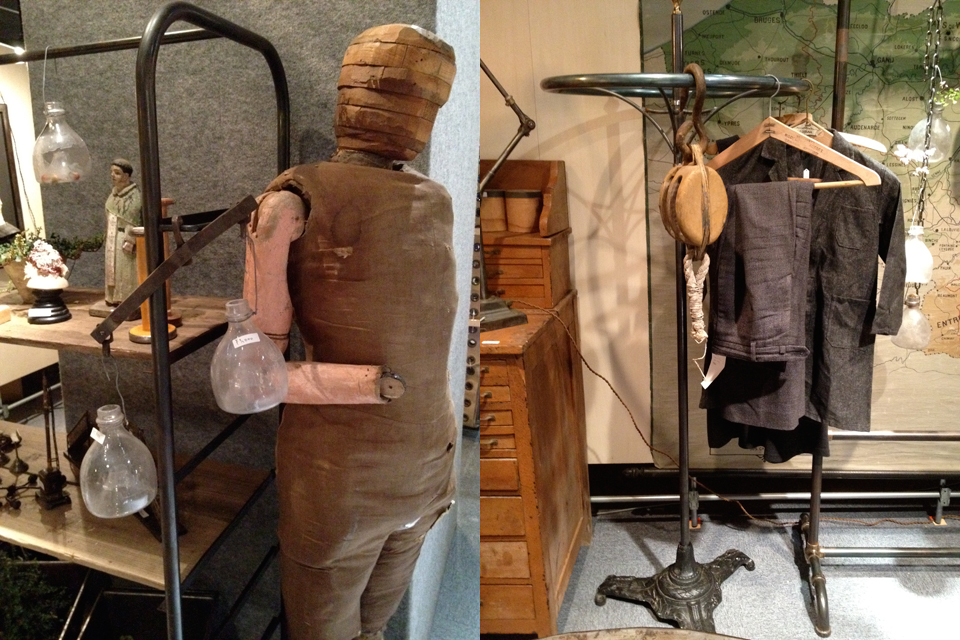
photos emmanuelle linard
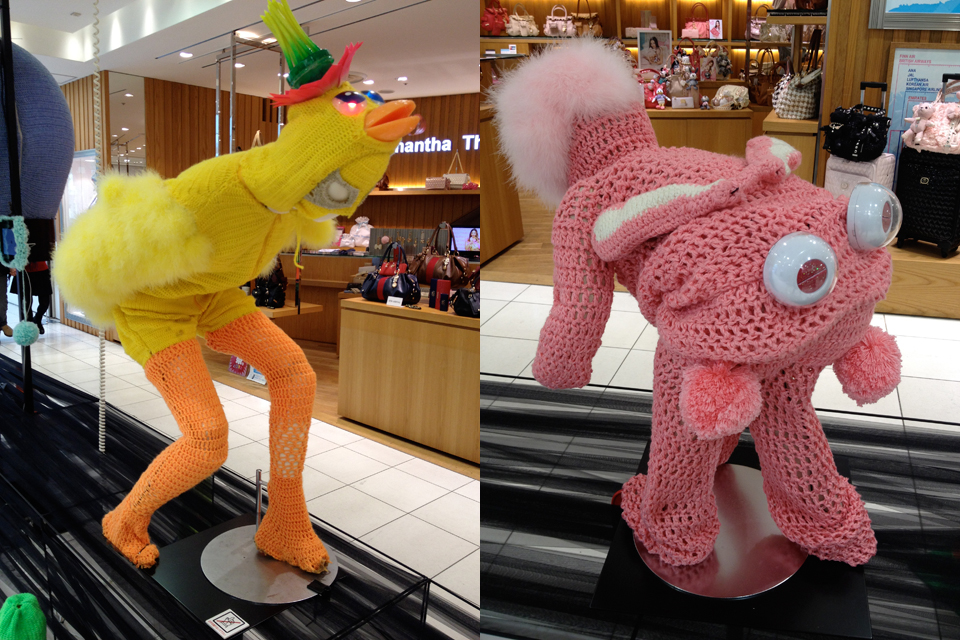
photos emmanuelle linard
High Fashion
Young people feel a nostalgia for their childhood, where everything can be trusted, where superheroes always win, where fondling is everyday's and everyone's body language. The high-street contemporary stores are filled with babywear items for kidults who do not want to grow up. Small tight jackets witH Superman prints are worn over large brushed cotton skirts printed in pastel tones. Hybrids garments of soft pajama fleeces and fuzzy teddy bear synthetic furs are ornate with pale naive narrative patterns.
A curved inscription on a sportswear sweatshirt reads “child sheep” as a statement of childish obedience and allegiance to the world of animals who are the only ones telling us the truth.
Contemporary stores at the Parco mall in the Shibuya district display these baby garments for young adults on walls of stuffed animals with patchworked deer and rabbit heads looking like benevolent monsters coming straight out of cartoons for the very young ones.
The trend for infantilism, always strong in Japan, is taking root even deeper.
At the same time, these animal heads are mounted like stuffed hunting trophies; a butcher display of stuffed jersey meats and sausages will shock more than one vegetarian eater. Are we witnessing a current for hunting activity?
Traditional British boarding school outfits mix tweeds and jerseys in fall colors, with tartan pockets and patched pieces of Barbour waxed surfaces.
A keen interest in the Fred Perry brand shows us that school uniforms call for preppy looks. Smart dresses blend a college vintage top with cut sleeves over a ballerinatulle bottom in a hybrid look.
Americana is still strong. Navy blue and white tailored jackets and sweaters embroidered with elusions and pinned with applique rosettes and merit medals congratulate us for being best human beings in a tough crisis situation. A much needed reward trend!
Young girls wore folkloric costumes for Japanese Halloween with full skirts and small bodices in bright colors.
White in winter invites the snow with fluffly down jackets, white boots and white porcelain jewelery.
Big down jackets in cold blue icy snow patterns make us explorers of the Arctic, and will be worn on top of wizard and fairy sparkles printed on navy starry nights backgrounds to make teenagers feel like modern day magicians. Also noticeable in fashion display, a trend for rag dolls as vintage dancers in a girls only troupe, reviving the era of swing and retro American girls bands.
Beauty
Long eye-lashes and extensions make eyes velvety while a pink haze of blush very high on the cheek bones makes girls look like fairies. Large braids around the head make Japanese fashionistas look like Tyrolian maiden. Red-headedor soft brown-haired princesses hold hands with platinum blond boys.
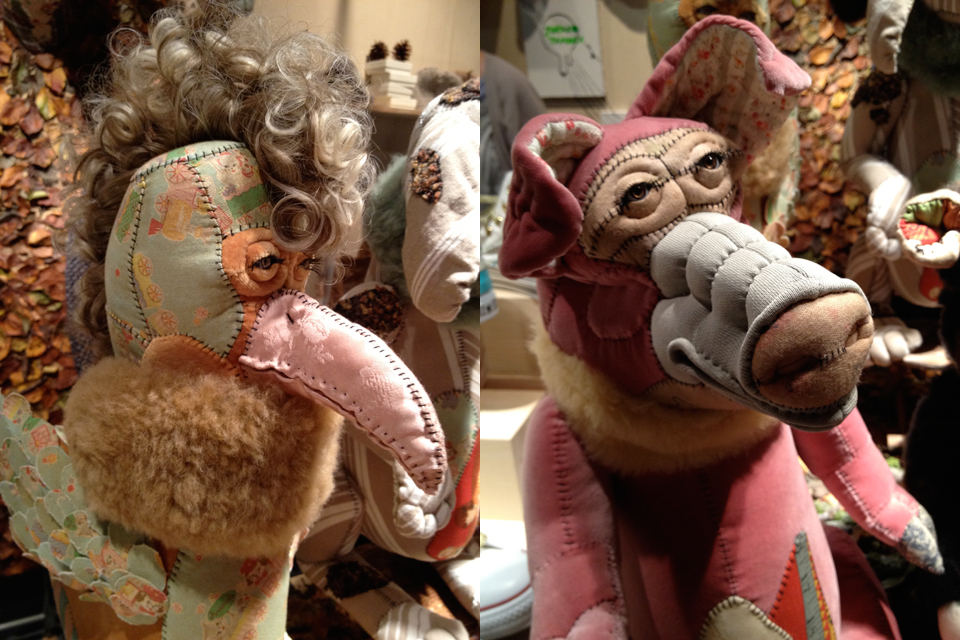
photos emmanuelle linard
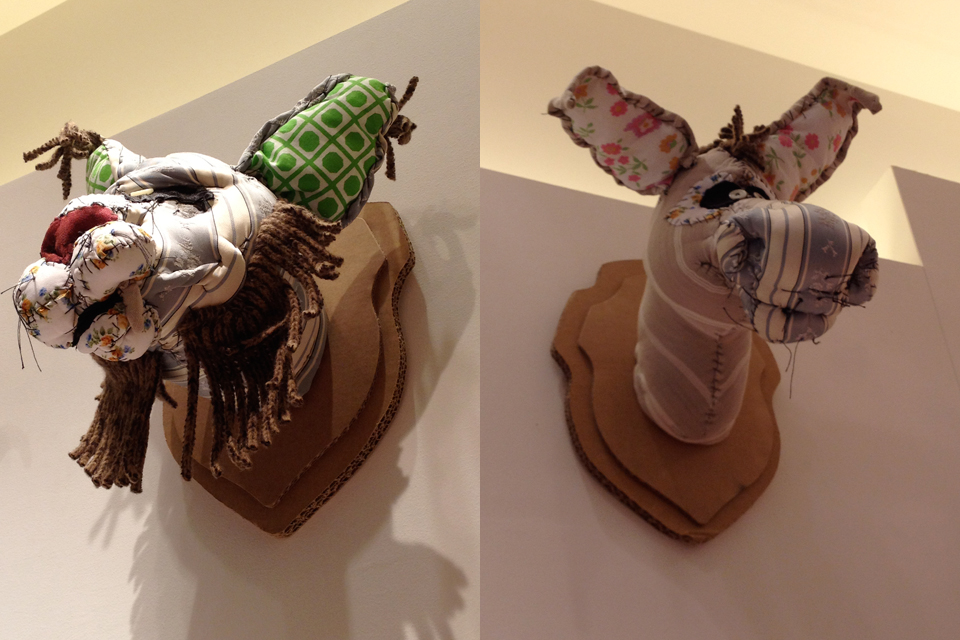
photos emmanuelle linard

photo emmanuelle linard
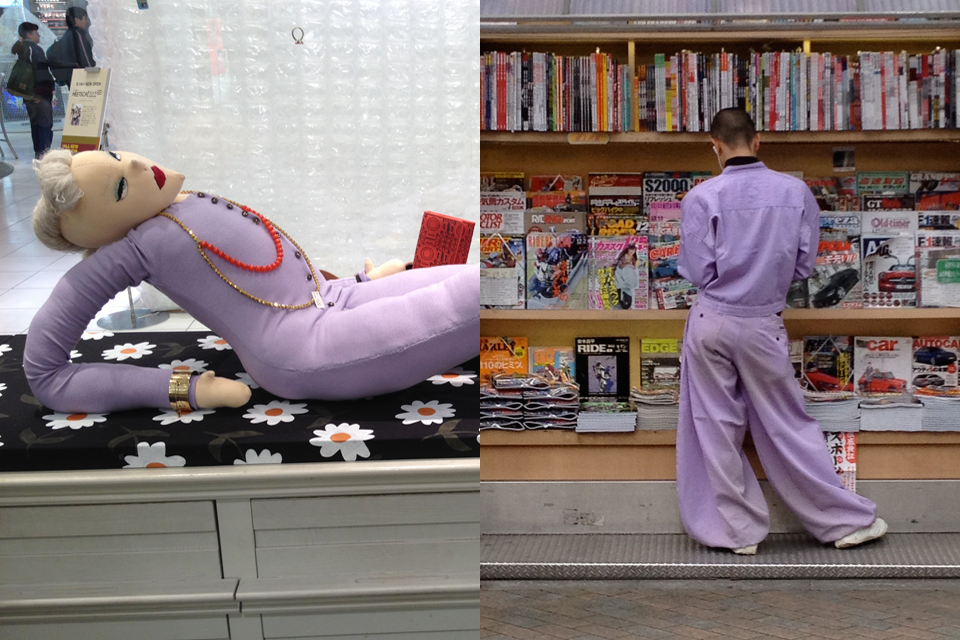
photos emmanuelle linard
Tokyo Design Week
The Tokyo fair Designtide held at the Midtown building complex exhibited some interesting works such as the “Bottleware” project by Nendo for Coca-Cola presenting crushed Coca-Cola glass bottles re-manufactured into plates and serving bowls, keeping the green tone of the original bottle.
Also noticeable was a strong waterproof material made of recycled scraps of stadium roofing tarps; this material is folded like origami paper or kimonos to create wallets and soft containers preserving preciously their content.
At Isetan Department Store in Shinjuku, a Baccarat exhibition “In Love With Harcourt” presents the cute “Crystal Candy Set” with cartoonish chubby crystal figures crafted by Jaime Hayon, and bilboquet toys by Decha Archjananun. The Black Guest in Japanese animation figure created for Llardois sweet.
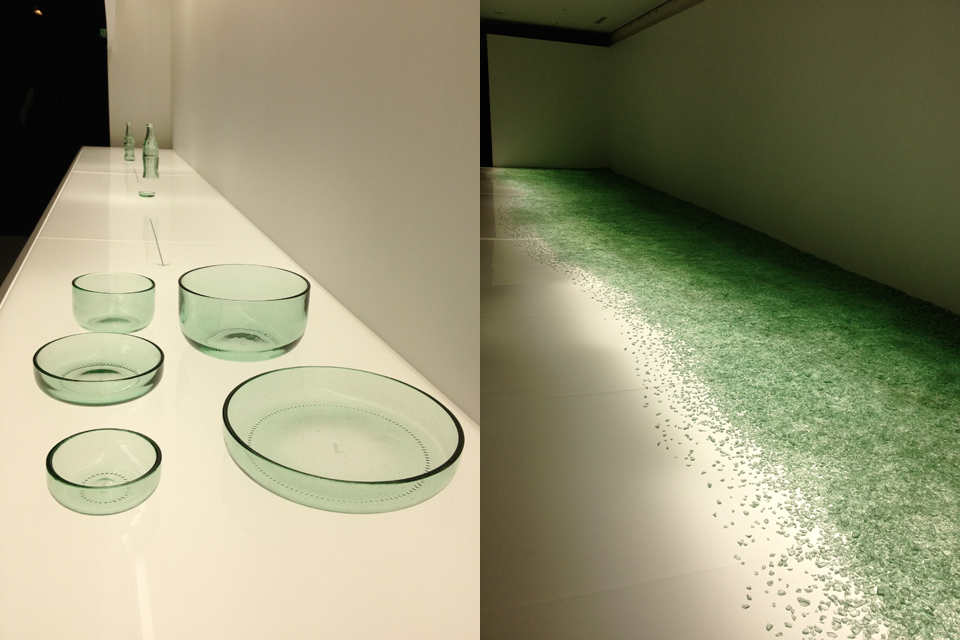
photos emmanuelle linard
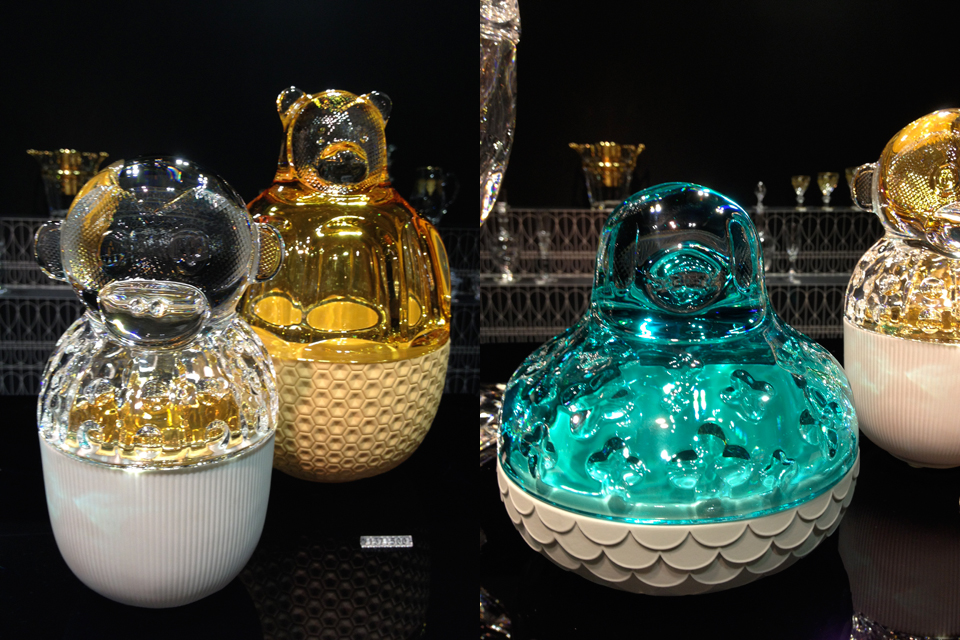
photos emmanuelle linard
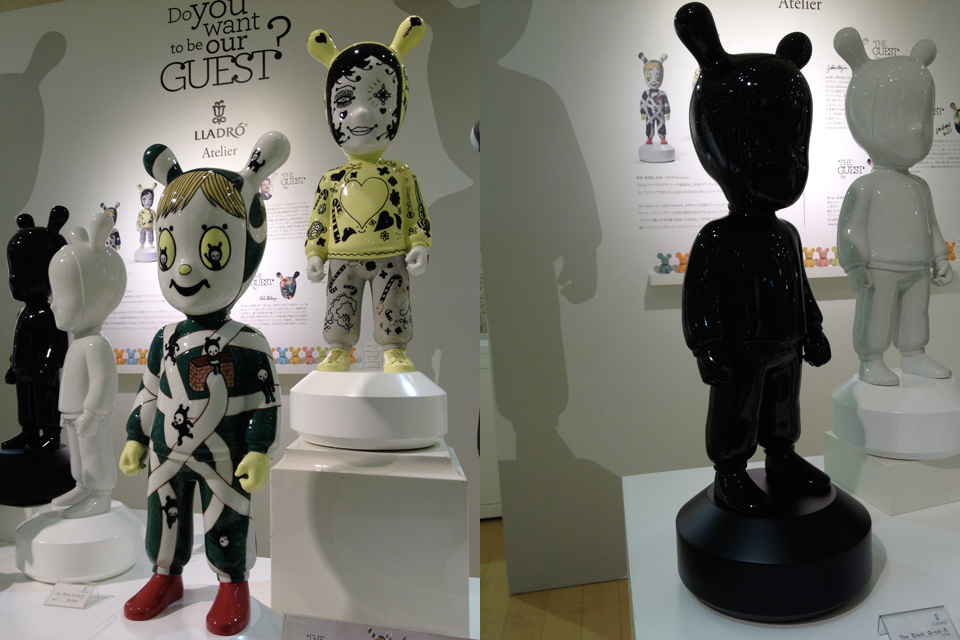
photos emmanuelle linard
Exhibitions
The exhibition on Ikko Tanaka, co-founder of Muji, at the 21_21 Design Sight museum, is a major curating work for graphic art & design.
An impressive collection of the master’s archives including books is on display, and I was particularly fascinated by a slideshow on Issey Myiake’s work in the 1980s representing the body in movement in the infamous savvy architectural cuts and pleats; a flowing dancing moment that highlights textile construction and pushes the human body to its ultimate wits of creativity.
An extraordinary art exhibition at the Museum of Contemporary Art Tokyo in Asakusa present “Art & Sound, a Synesthesia" curated by musician Ryuichi Sakamoto: a large blue pool of white ceramics floating by Celeste Boursier Mougenot produces a crystalline chime each time the containers collide into each other.
A video installation by Christine Odlund “Stress Call of the Stinging Nettle” shows a chart accompanied by sound of the defense mechanism triggered when the plant is in danger; chemical gases are released by the nettle leaf once attacked by a larva, warning the neighboring plants to evacuate nutrients contained in their foliage down to their root system.
A large installation by the Otomo Yoshihide Ensemble entitled “With Without Records” presents a plethora of vynil record music players stimulated by objects dangling from the ceiling, each playing in their turn.
A new way to understand the interaction between art and sound.
By Emmanuelle Linard & Kaori Ieyasu
follow the early bird

photo by jamesjustin / creativecommons
“The early bird gets the worm”
Yes, it is good thing to wake up early, feeling the fresh air around us, taking time before rushing into the busy day. More and more “early birds” can be seen in Tokyo nowadays and there are various “morning activities” and services for them~
“Breakfast for the early birds”
Cafes and restaurants serve various kinds of wonderful breakfasts from vegetarian specials to steak in the morning for the powerful people. Now Tokyo can be the best place to taste all kinds of breakfasts from all over the world!
“Morning market”
Tokyo is an urban city surrounded with concrete buildings and busy information. People need some rest and want to taste slow & fresh vegetables & fruits directly from farmers, enjoying short conversations about the weather and the recipe. In Roppongi, Aoyama, and Shibuya (these are known as fashionable and trendy spots), you can find wonderful markets on weekend with lots of fashionable naturalists, carrying dogs and kids and straw baskets.
“Morning lesson”
There are many lectures to inspire the brain and also many lessons to wake up the body. In Marunouchi, you can take morning class about health and foods, economy, politics and so on. In the park, you can find many groups who are enjoying to dance and stretch and workout.
“Morning drink”
Morning is the continuous moment from night and some people enjoy the morning beer and sake under the fresh morning sun. Of course there are many new products to wake you up happily in the morning. New alarm clocks, new aromatic disposers, new sound systems and new beds to give you a deeper sleep and wake you up earlier.
As I see this tendency, it seems to have a similar background with greener urban Tokyo scenery. Elle Decoration has a special issue about “living with green.” You can find many new commercial buildings with green walls and roof tops.
We certainly feel green more than before. It may be the balance from stressful urban life, being chased after routine work, polluted air, and no trust toward food in super markets. Then we need more green and more fresh air to keep our sense healthy.
Having breakfast with friends and riding bike to the company with fresh vegetables in your bag with an ipad. That is the new work style in Tokyo.
Kaori Ieyasu
go local!
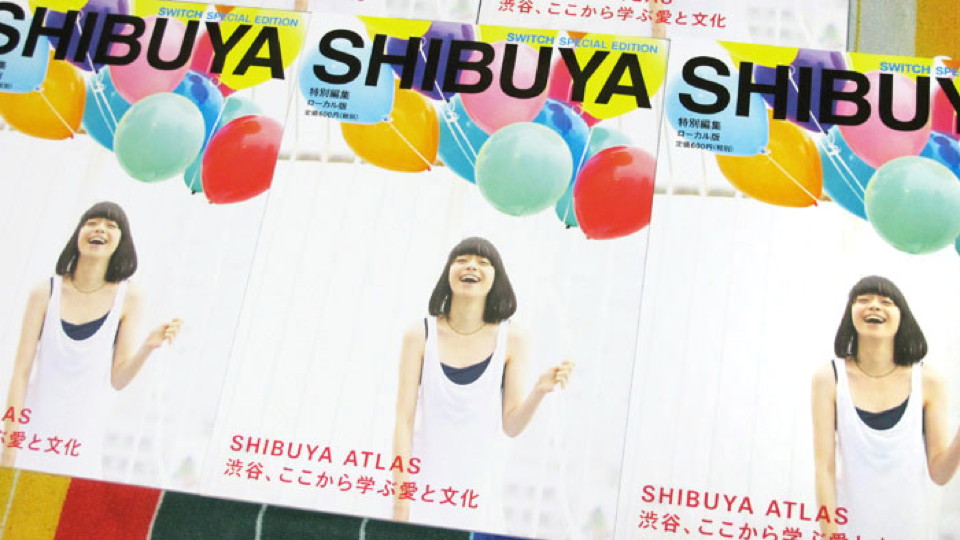
We are living in the huge scale of the world, surrounded by the enormous amount of information delivered every second. If we live in one specific space, we feel like living in the big stream of earth. It is so hard to feel something real as if everything is just image.
To get the balance, we climbed up the mountain and it was the “mountain girl” boom. In Tokyo, we enjoy running around the emperors castle and there are many new business like “runners’ café” offering a quick shower and refresh service for those who need to go to the office after. The new strong movement that we see in Japan is “local”. Lidewij Edelkoort has been forecasting it since several seasons and it is really coming up to the surface.
A very good example is the magazine SHIBUYA, the special edition of SWITCH MAGAZINE. What is new is that it is not a special theme for the regular magazine but a magazine for the real local people to better explain them their city.
It's not a travel information book, it's about Shibuya where we do shopping, eat and work. In this magazine, Shibuya is not seen as the icon of shopping and culture but as the local town.
Nowadays, when we think of traveling we google the web and blog to get the information about our destination. We don’t feel like buying travel books anymore. Why? Because they don't seem to be trustily information, we smell the sponsorship and the control of information behind. We prefer to trust someone’s real experience and the information from people who live there. Sometime, these informations tend to be a little too private.
This magazine is just in between the private view and professional (editor’s) view, you can really find something you have not seen before.
Kaori Ieyasu
modern origami
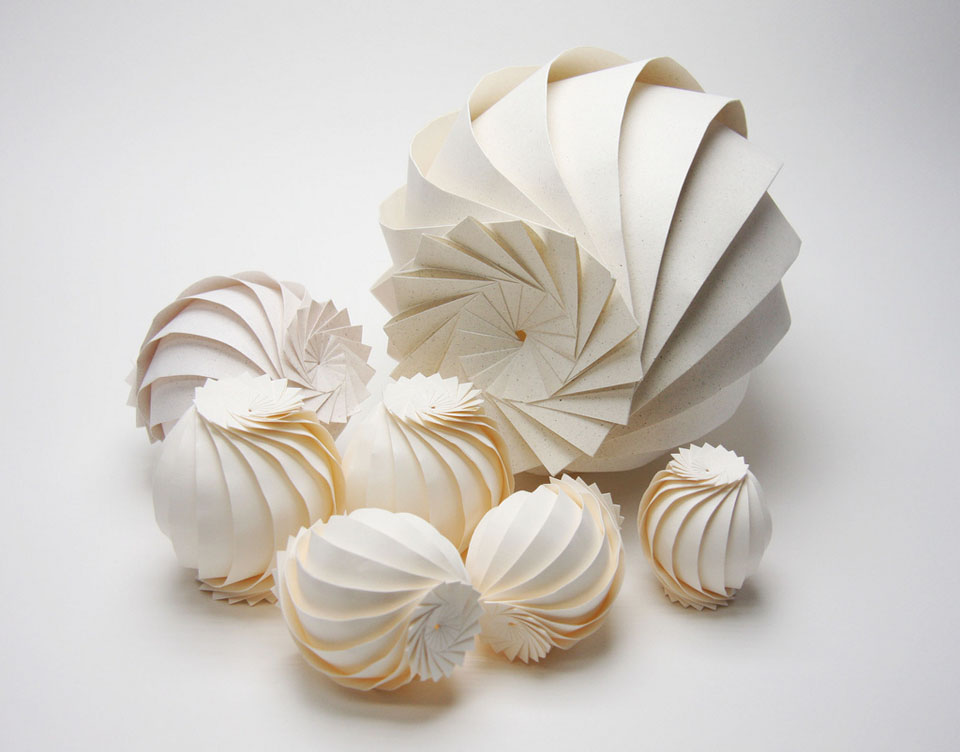
design & photo jun mitani
Jun Mitani is a computer engineer, but he's also a paper artisan; he designs origami pieces with computer programs that he develops himself. Seems complicated ? Not for him, as he explained to us: "My speciality in the field of computer graphics is geometric modeling, so it's not difficult for me to develop computer programs for designing origami once the underlying theory of origami geometry is clarified."
The beauty of his creations might be in the clearness and smooth complexity of the shapes, almost just curves.
The form is completely calculated by computer, it looks like an impossible things to make with just one piece of paper, but it is; Jun first start to work on his program, explores variety of origami shapes before he began to fold a sheet of real paper.The programs generate a crease pattern (a pattern of valley fold lines and mountain fold lines).
The pattern is scored on a sheet of paper by a cutting plotter. With these digital devices, now these sophisticated origami pieces are realized.
That's why his art work is not just the folded origami pieces but also the software programs.Recently,Jun Mitani collaborated to"132 5. Issey Mikake" collection.Those three-dimensional garments are not cut or sewn but folded with permanent pleats. Invisible snaps allow the garment to be adjusted and fitted to the body.
Jun Mitani creations are really at the confluence of Art & Science, one of the long term trend for the future.
Text by Caroline Aufort.
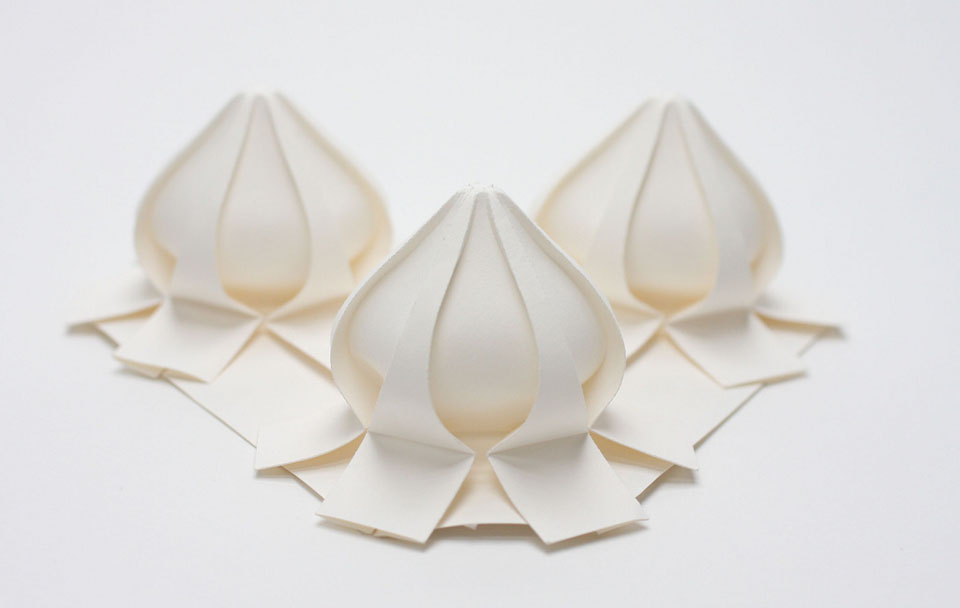
design & photo jun mitani
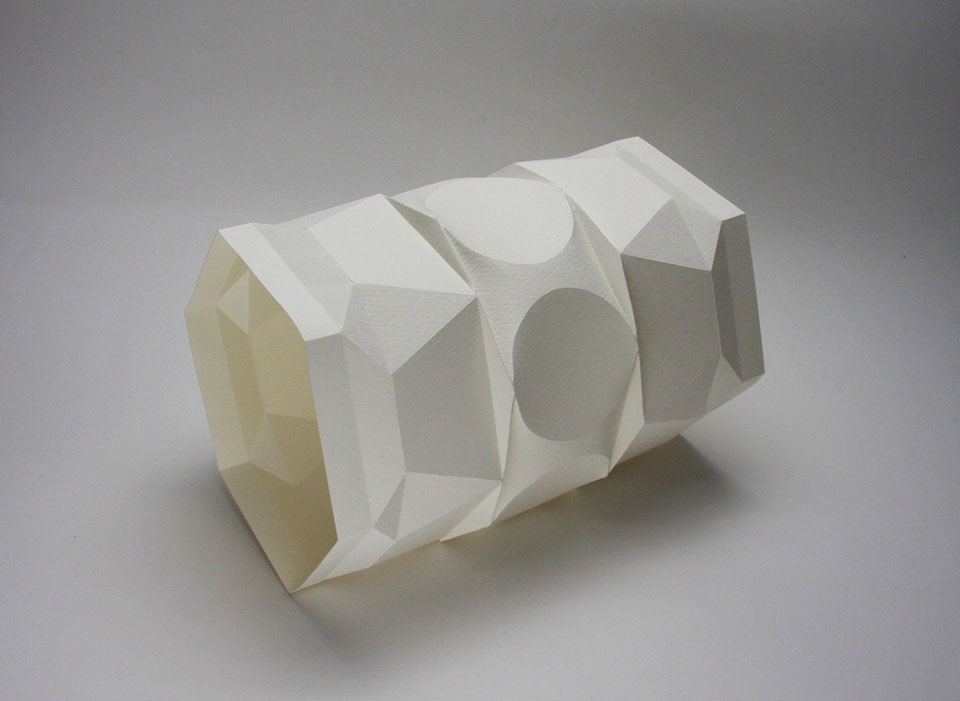
design & photo jun mitani
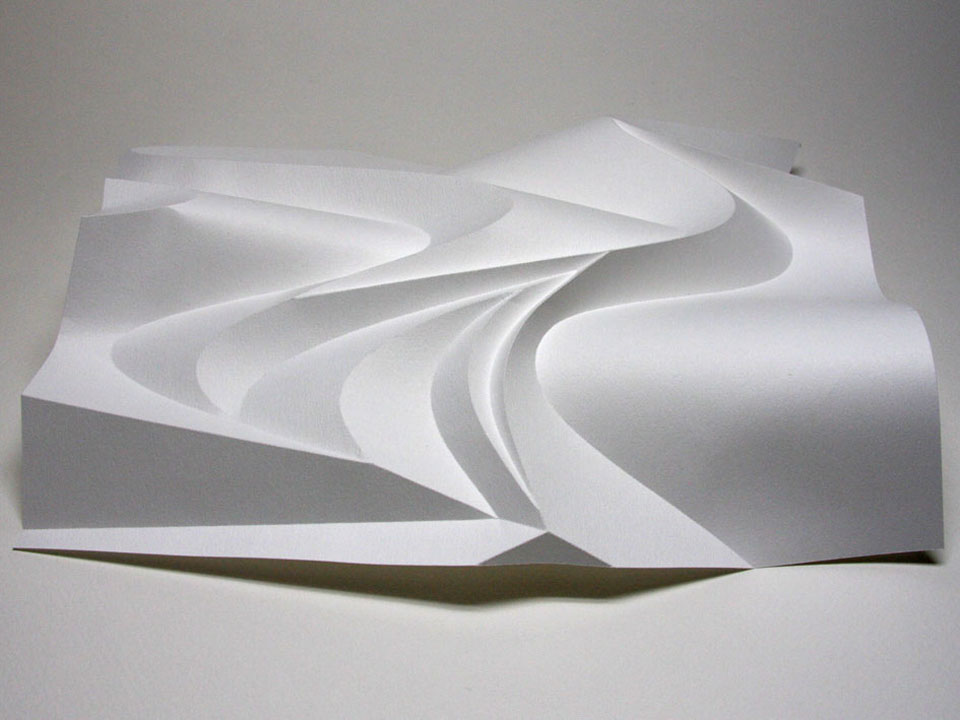
design & photo jun mitani
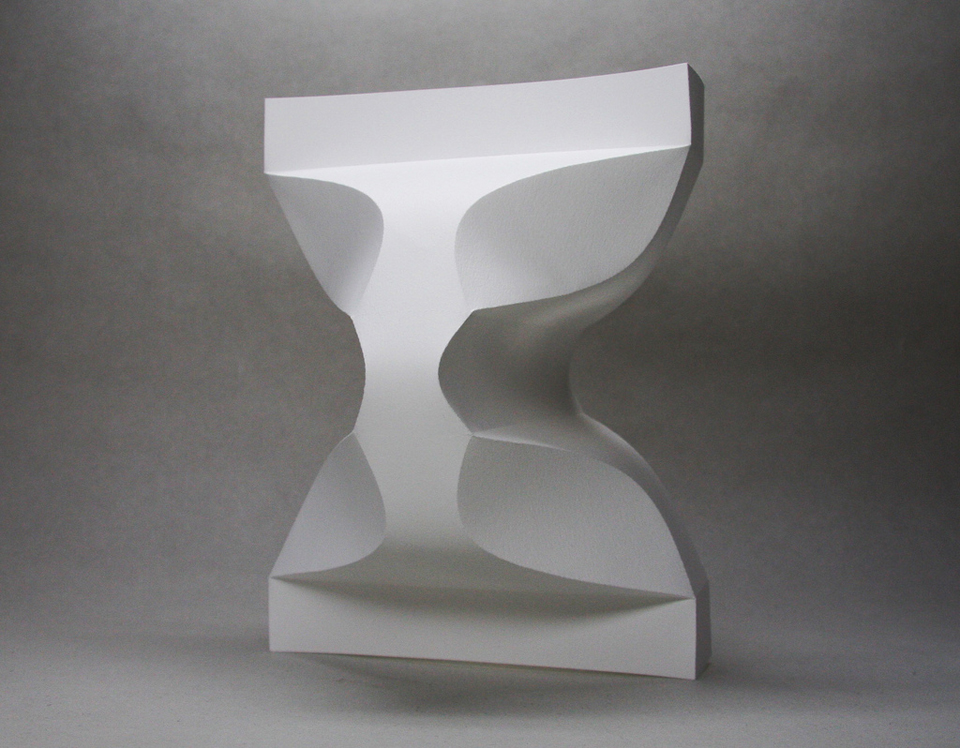
design & photo jun mitani
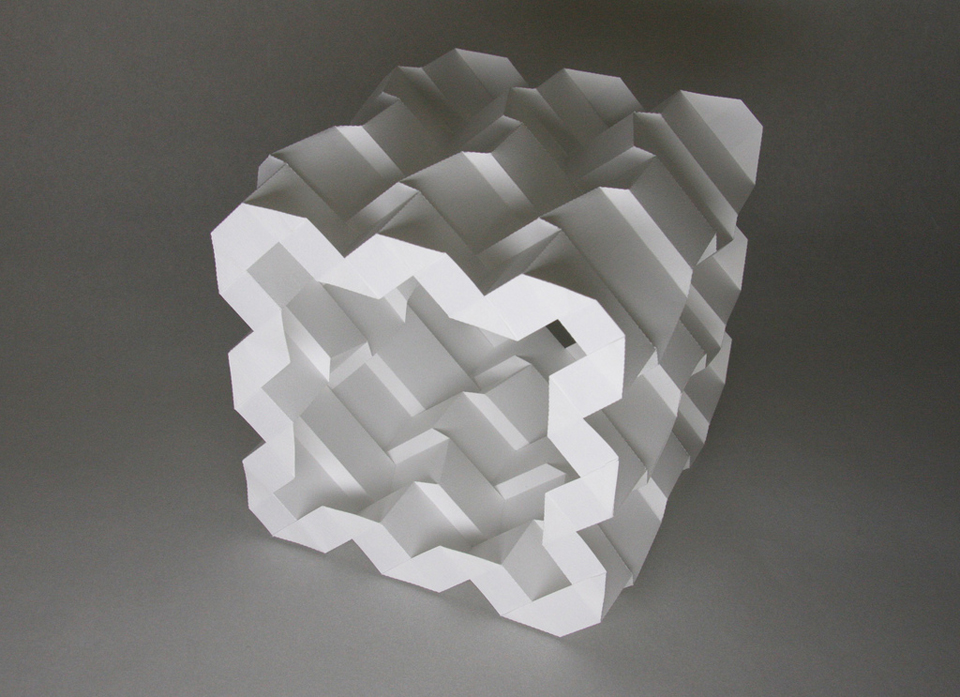
design & photo jun mitani
colour porcelain
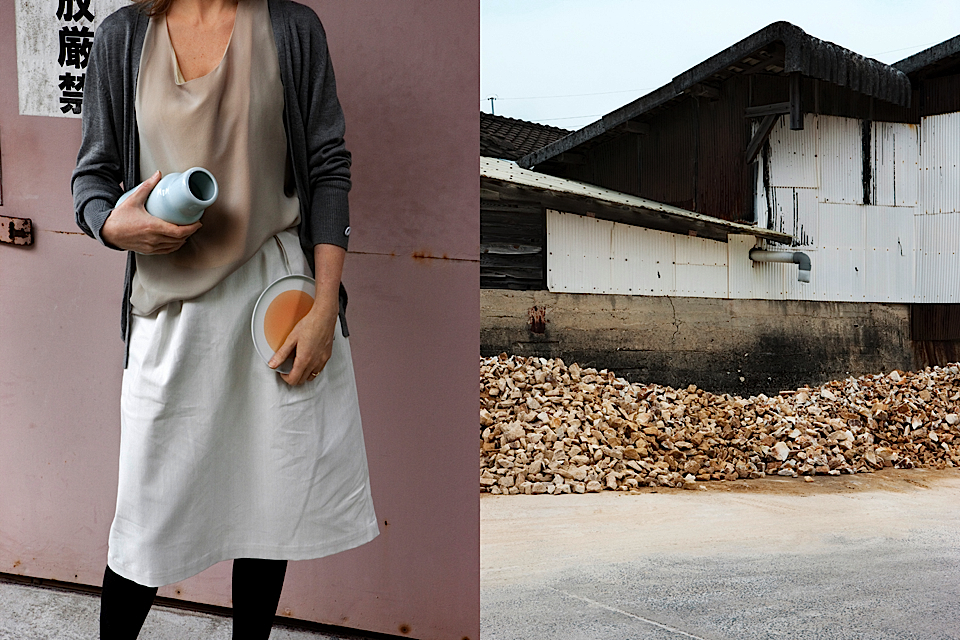
photos by inga powilleit
At the request of 1616 / Arita, one of the oldest Japanese porcelain manufacturers, Scholten & Baijings has designed a very comprehensive porcelain service that was launched at Spazio Rossana Orlandi during the 2012 Salone del Mobile. The collection consists of three series: Minimal, Colourful and Extraordinary.
The distinctive Japanese Arita porcelain is renowned for its superb quality, where fine hand-painted decorations play a central role. The tradition of porcelain painting dates back to 1616, when the abducted Korean potter Yi Sam-Sam-Pyeong discovered a superior quality clay in Arita.
For the collection of 1616 / Arita, Scholten & Baijings prepared a colour analysis involving historical masterpieces. Typical Japanese colours, such as aquarelle blue, light green, red-orange and yellow ochre, were the ones that played a prominent role.
These colours have been used individually in the new designs, but together they form the specific Arita colour spectrum.
The results are layered colour compositions, executed in different shades of glaze, in combination with the natural porcelain colour. The latter has a special delicate grey-white hue, which makes it unique in the world.The names of the series refer to the amount of colour, details and patterns used. 'Colour Porcelain - Extraordinary’ is the most elaborately finished version.
By applying the compositions to an extremely functional service, an interesting dialogue has been created between applied art and everyday use. The combination of this traditional craftsmanship and Scholten & Baijings’ recognizable signature style has resulted in a unique mix of Asian and European culture.
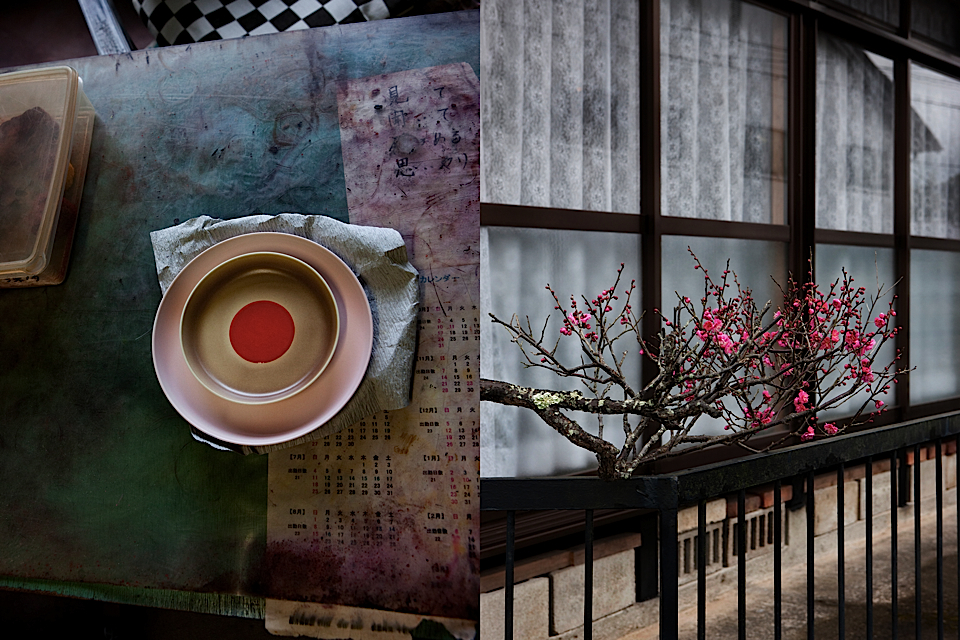
photos by inga powilleit
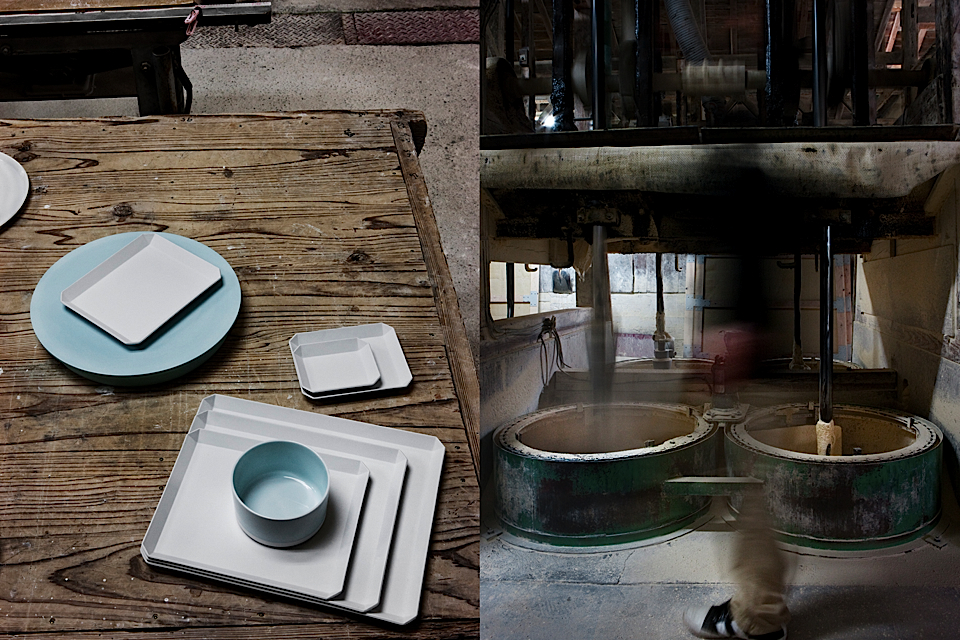
photos by inga powilleit
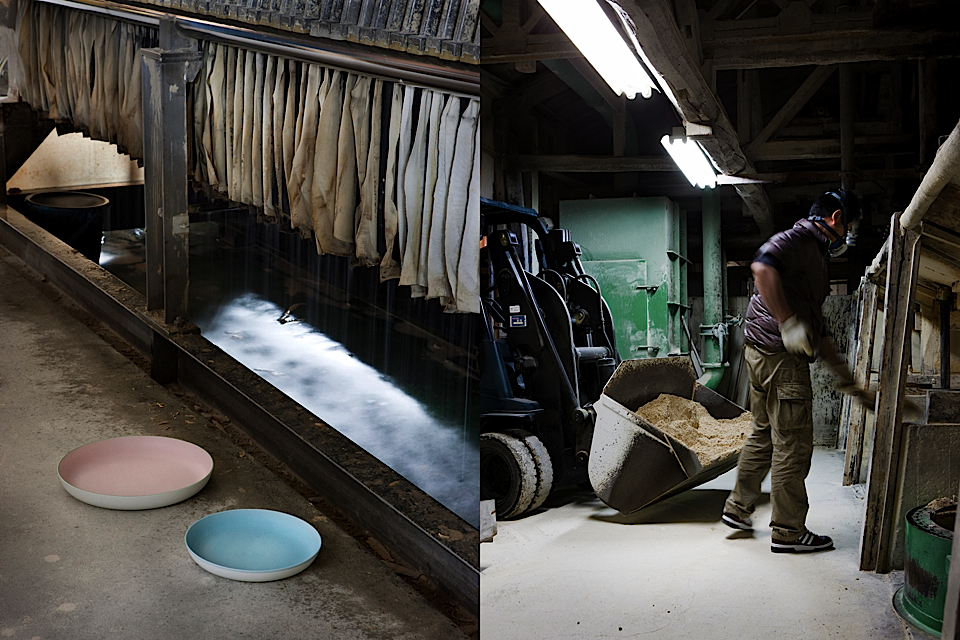
photos by inga powilleit
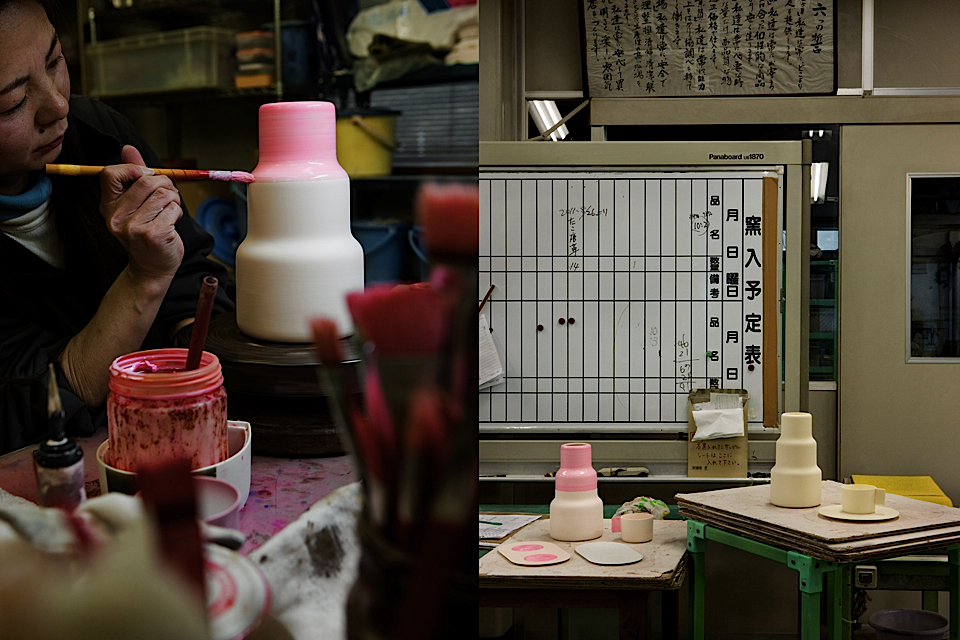
photos by inga powilleit
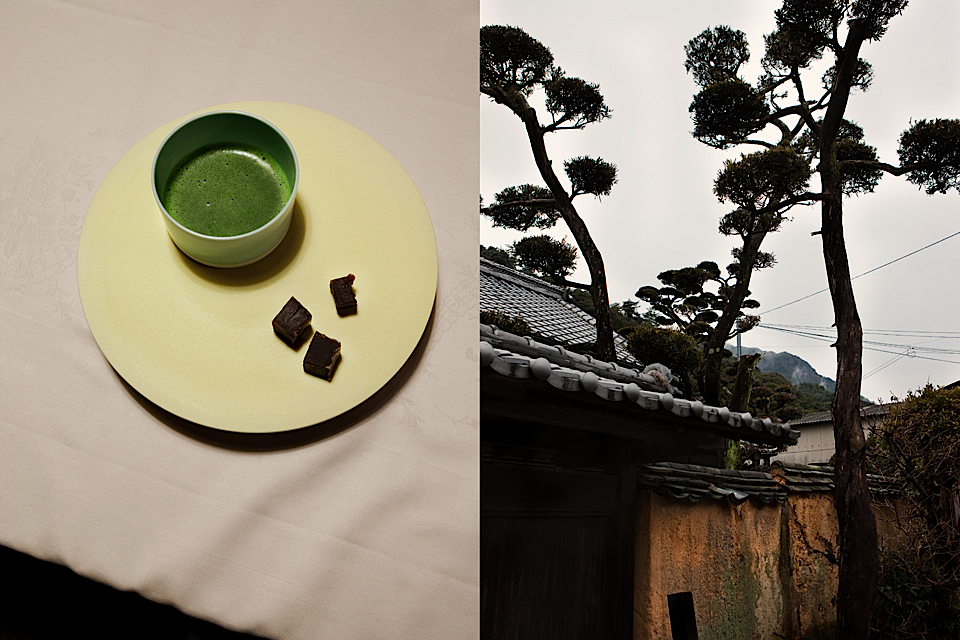
photos by inga powilleit
healthy & fast
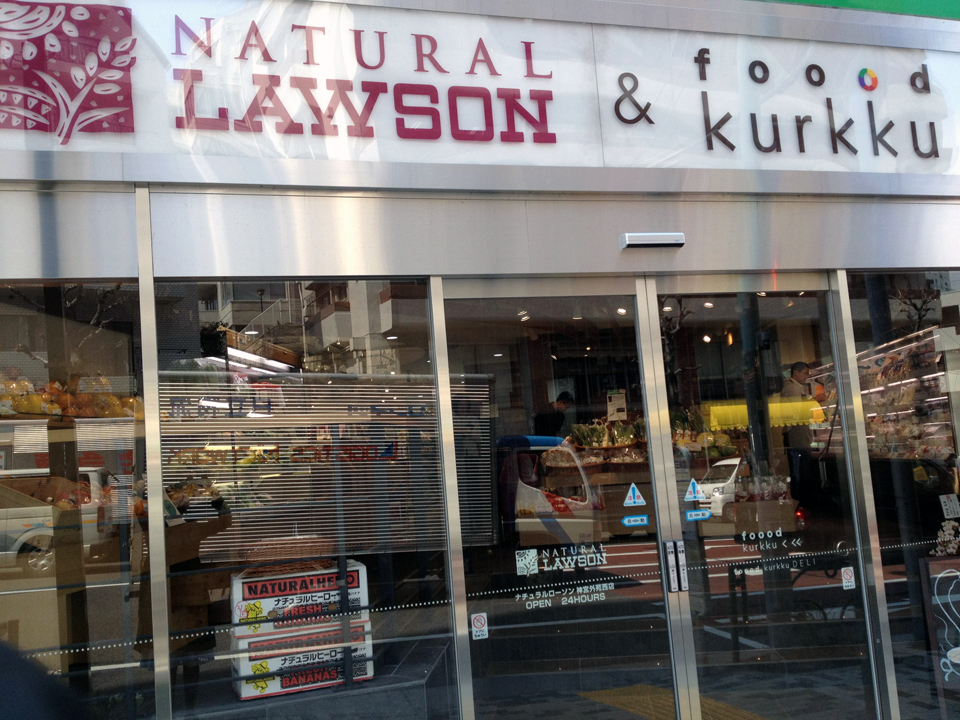
photo by kaori leyasu
“Fast” has starting to invade all the market for a while: fast fashion, fast food and so on… everything requires to be quick, to be new but tend to leave the quality behind.
Our life is becoming more and more busy, with work, friends to see, projects to make, and we don't want to use our time for other things. That's why we want things to be quick. But now, we started to have a desire of quality and richness with slower things: slow food, slow living.
Something new, for busy people who want slow life, was created in Tokyo: a convenience store open 24 hours a day.
Normally, this kind of store sells fast food and industrial products (ready made lunch, salad, snacks, noodles, magazines, drinks and medicines.) In this new store, called “natural lawson & food kurkku”, fresh vegetables, fruits, meat and fish are sold. Everything is organic, coming directly from farmers. The staff makes a selection of products based on taste and quality, telling customers where it comes from and how it was made.
They got great Japanese wines, and next to the registration, you can buy brown rice by measure. In the basement of the shop, burgers and wine are served.Kurkku is a project runs by musicians, who want to connect producers/farmers with consumers to create a better life and future.
They have already opened 3 restaurants in Tokyo offering wonderful organic food. For this new shop, they want to combine quality of slow food and fast way to serve it.
The shop is located in Harajuku and during lunch time you can see fashionable young people: lot of fashion designers, hair stylists, shop owners… all coming to have a great slow food lunch in a short time.
That's exactly what's nice there : they don’t deny the convenience of fast store but instead, they try to create a new speed, just between fast and slow.
Kaori Leyasu
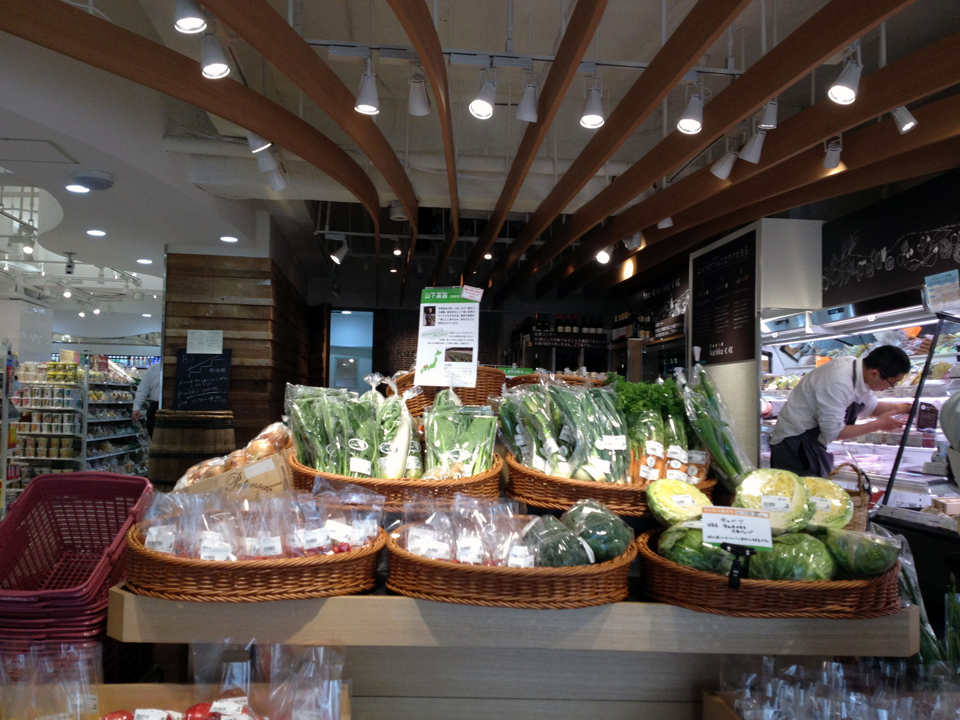
- photo by kaori leyasu
pastel spring

photo by kaori leyasu
Since ancient ages, in Japan, we have been loving the cherry blossom season as the new start of life after a long winter.
April is the month of a new start: it's the new school year, it's also for companies the time to welcome new employees. The cherry blossom always relates with the excitement of something new and also brings melancholy for something gone.
Spring is often very stormy and rainy and many beautiful poems and lyrics express people's worry about the fragile beauty of blossoms.
"if we don' t have the cherry blossom in spring, we can relax and enjoy spring more."
"do you know something you can protect the cherry blossoms from cruel wind?
I try to cover her with my big sleeve now."
This is an old poem written more than 1300 years ago and we still have the same feeling now.
Why are we so much attracted by this flower as we also have other beautiful flowers in spring?
It may be because of its short living beauty,staying only few days.
It may be because it's magical color which suddenly changes the world pale pink in one night.
Always they make us realize by the beauty of this season and the richness of nature that we live in a constantly changing world so , we need to enjoy every moment.
This spring has been very cold and the cherry blossoms bloom later than usual.We had been looking forward it .
This season there are a lots of pastel color clothes and bloomy lace fabric in the fashion shops.
Everything seems to let us enjoy the short alive spring.
Spring shopping has started now with the beauty of the blossoms.
For a while, we have a pastel colored spring in Japan!
Kaori Leyasu

photo by kaori leyasu
In touch with JAPAN
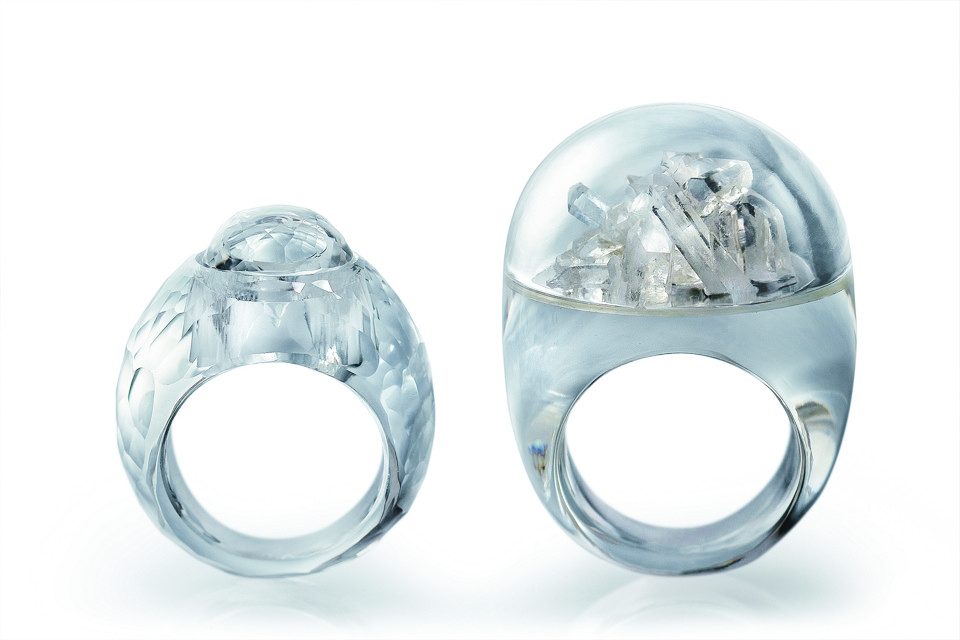
Same as other places in the world, craftsmanship is in danger behind the industrial mass production in Japan.
But since we are getting bored with non-face products surrounding our life, we started to realize again the quality of hand made product, each has its own story, character and taste.
Studio Edelkoort and Edelkoort East (japan office) has been working with crafts men from Yamanashi to develop their products using their wonderful technique and tradition, combining with new perspective of what we want to have in our life.
This time, three projects were showed at Studio Edelkoort during the fashion week in Paris.
It is textile, jewelry and paper. You can see that the trials of young craft men who have taken over the family business and try to explore the new possibility. Wonderful technique of weaving, curving stones and surprising world of paper will be a good inspiration for who want to create something humanity and new!
Each product has own taste and touches which tell the craft men’s identity.
4th March, Sunday afternoon and 5th Monday, they will sell their ties and also you can order your own jewelry!
Text by Kaori Leyasu
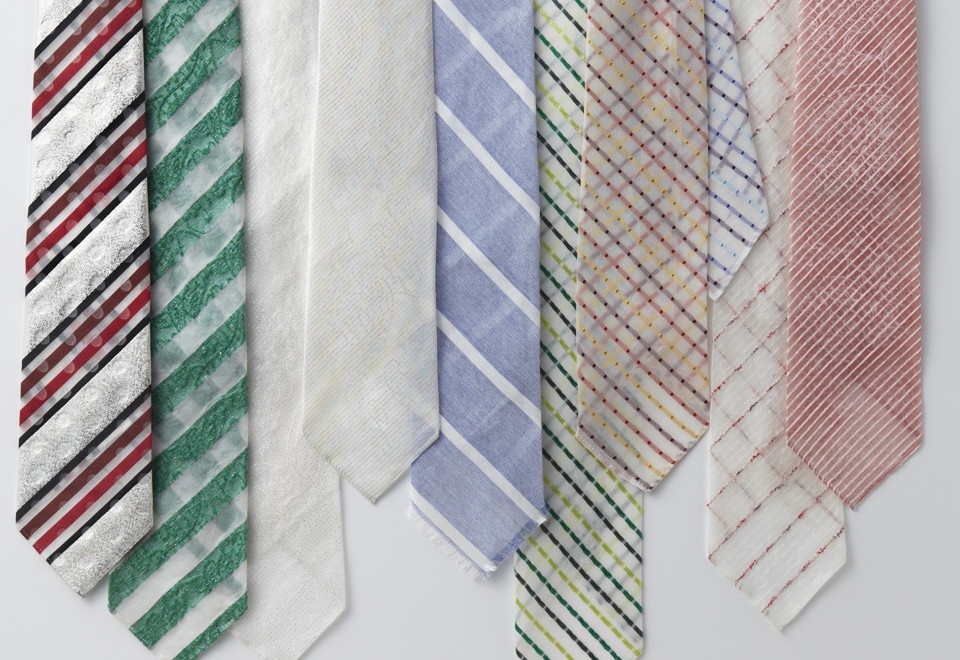
new richness in new style of shopping center
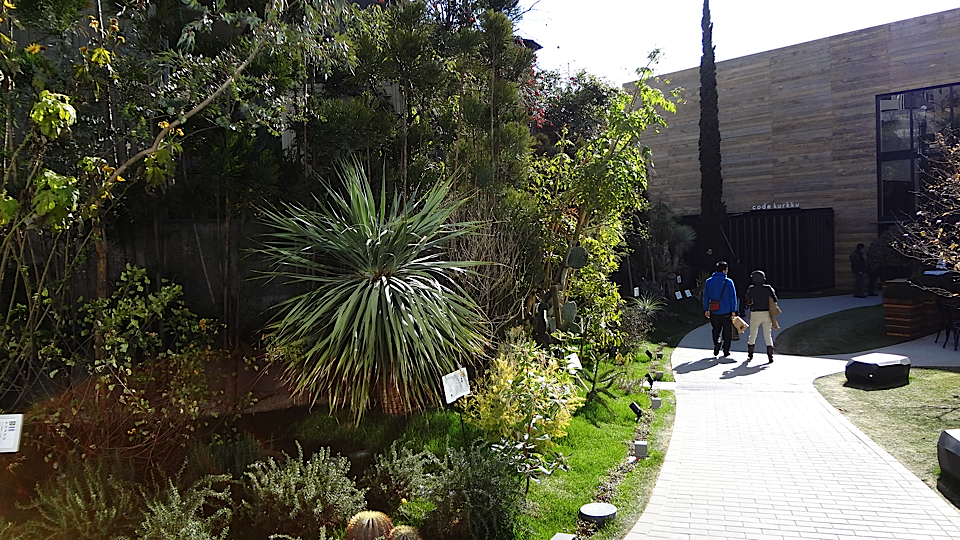
photo by kaori leyasu
We are tired of shopping in the mall where all the shops are the same and they sell plenty of boring things.
But now in Tokyo, two new shopping malls have appeared and obviously they propose totally different joy of shopping.
One is in Yoyogi, next to Shinjuku, student area.It is called Yoyogi village. It is really like good small village, as they have 1 tasty bakery, 1 tempting smell of coffee shop, 1 good bar, 1 fabulous Italian restaurant, 1 travel agency, 1 small &intelligent bookstore, and 1 garment shop which concept is “one mile wear”. Every store in this village has certain reason to be chosen. They are nothing like others, just simply good quality.This is directed by musicians and architects.
The other one is in Daikanyama, a very fashionable place for young with wonderful vintage clothes, and nowadays this area attracts adults with babies. New shop is Daikanyama T-site. It is called “Otona Tsutaya(= Tsutaya for adults).What is interesting with this mall is that the book store is in the center of this mall. Tsutaya is the bookstore which has been developed with CD and movie rental service combination since 1983.
Nowadays we download the music and movies and even we read with tablet so that the number of people who visit store has been declining.
But this mall proposes the pure joy of being in the bookstore, which has wonderful selection to cover our curiosity, and happy to get lost in the store like labyrinth.
In this mall, there is a restaurant whose concept is “global comfort food”, an electric bicycle shop which is the must item for Tokyo life nowadays, a grocers for dogs, a toy shop for kids and relaxing outside space to have tea and read the books.
From these two malls, what we can find is that we want to satisfy our intelligent curiosity and we feel happy with the “bliss of life”.
Text by Kaori Leyasu.
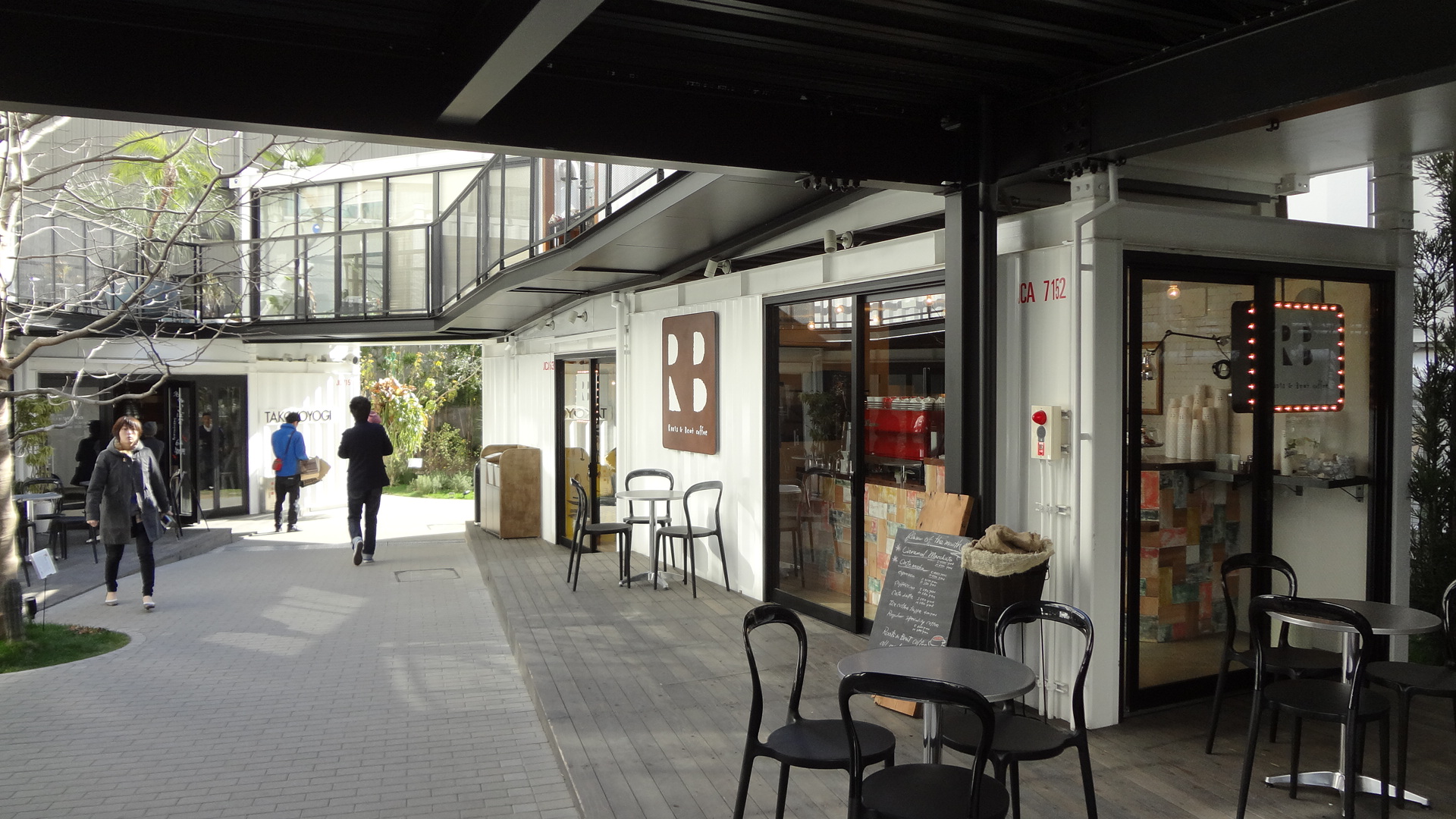
photo by kaori leyasu
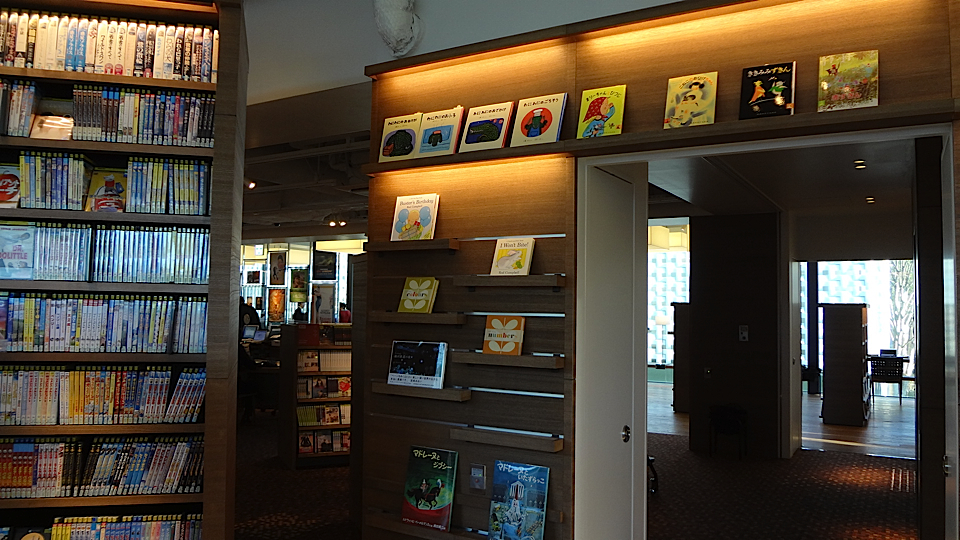
photo by kaori leyasu
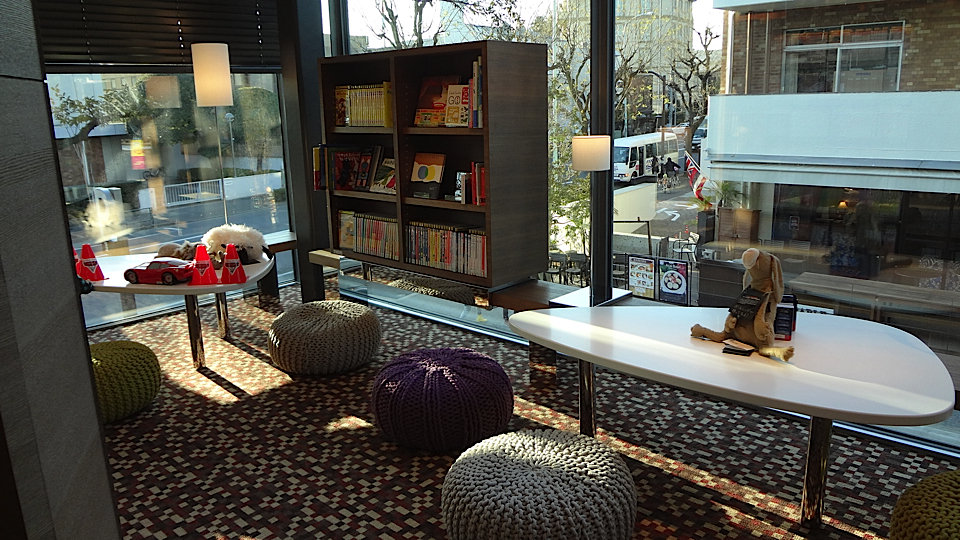
photo by kaori leyasu
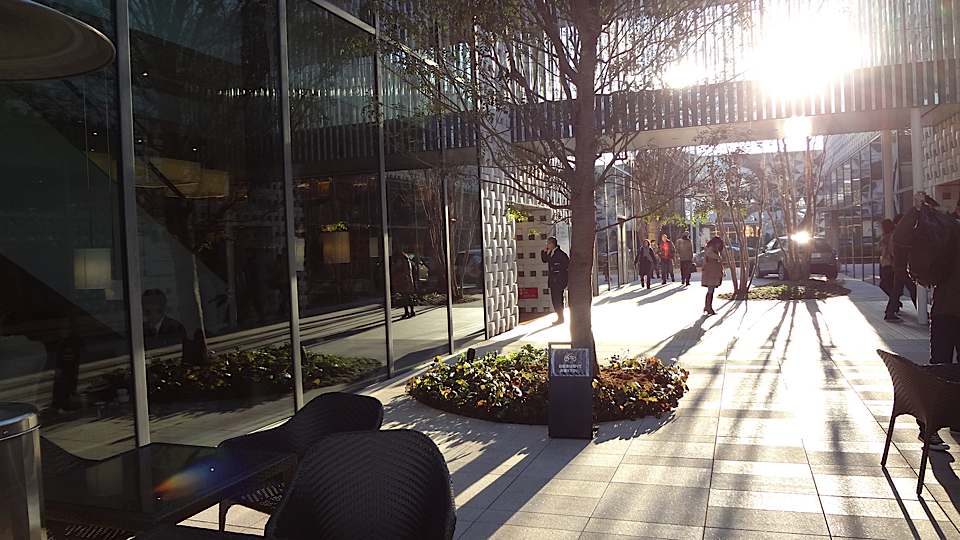
photo by kaori leyasu
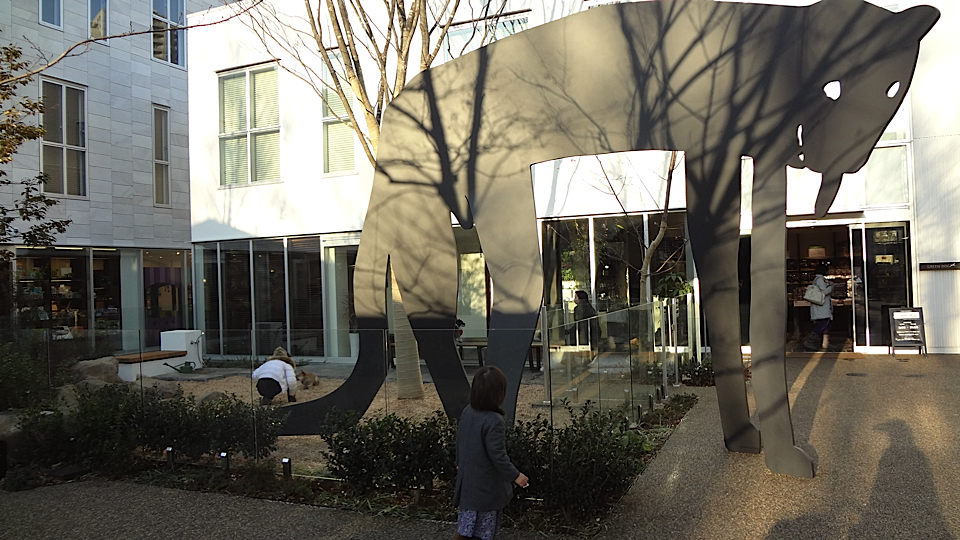
photo by kaori leyasu
the kimono connection
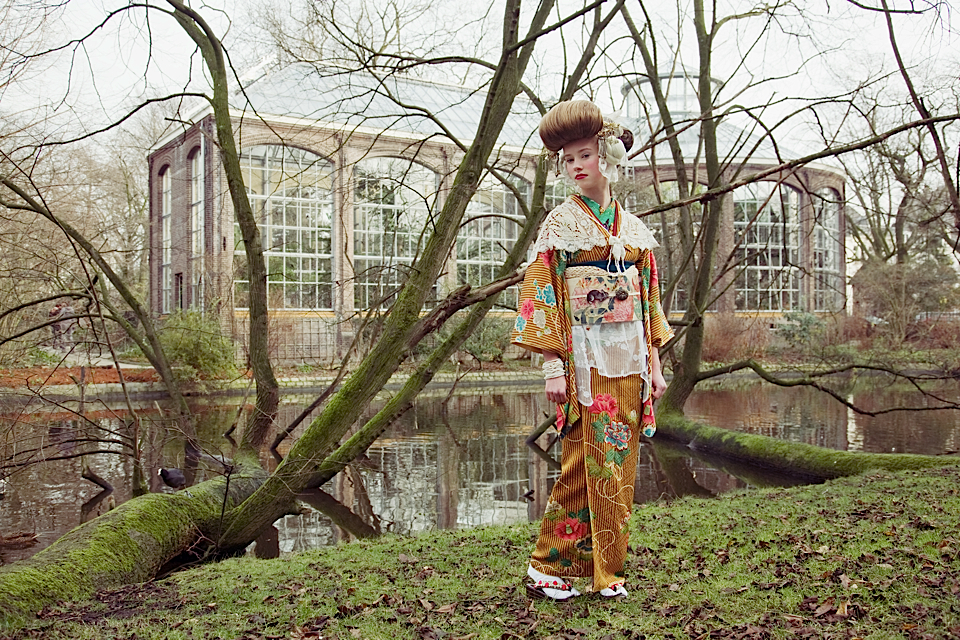
copyright: Mieko Ueda/Mamechiyo photo by Ayumi Hase
Mamechiyo describes her kimonos as modern landscapes, where the Eastern and Western worlds collide. Her kimonos are akin to puzzle pieces, bridging disparate moments in history: both contemporary and classical. Often coordinated with different obis depending on the occasion, Mamechiyo’s creations mirror significant shifts in the global imagination.
There are no boundaries for Mamechiyo; the old and the new worlds stand side by side, illuminating what it means to live in an increasingly intimate world, where memories of the past and dreams of the future are inescapably entangled. As we share more of our lives with the rest of the world, we cannot help but be energetically transformed by these cross-cultural exercises of style and sensorial didactics. Text by Beth Lauck.
The pictures we are happy to publish were taken in Amsterdam, new home of Mamechiyo, and are a collaboration between Mieko Ueda and Mamechiyo.
Hair-Make-up Artist-Beauty Director: M. Ueda @Shiseido
Kimono Artist-Designer: Mamechiyo
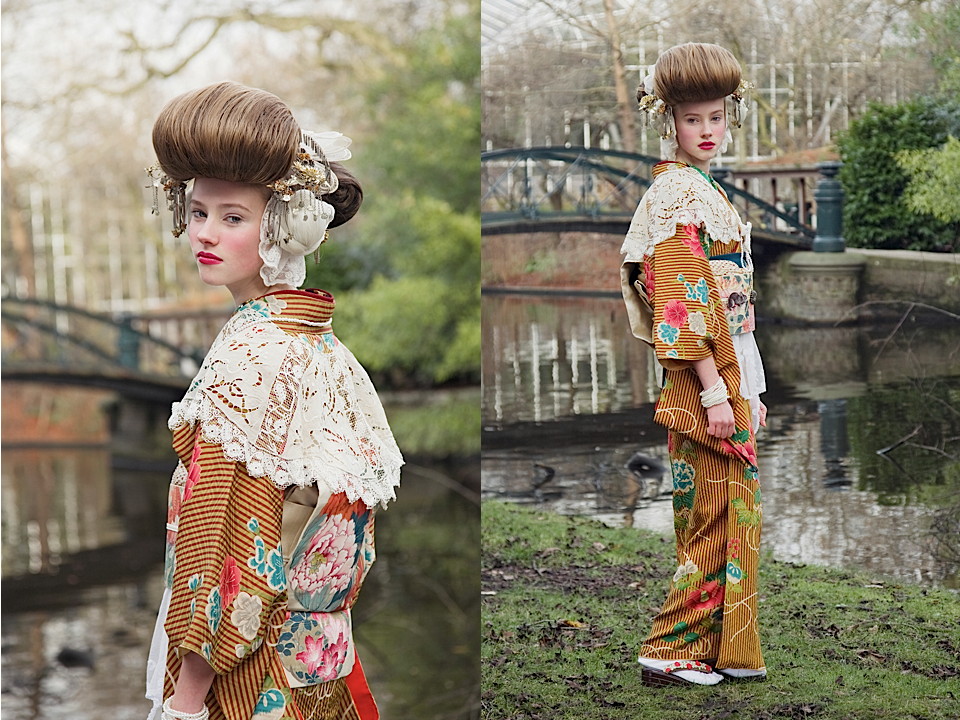
copyright- Mieko Ueda:Mamechiyo photo by Ayumi Hase
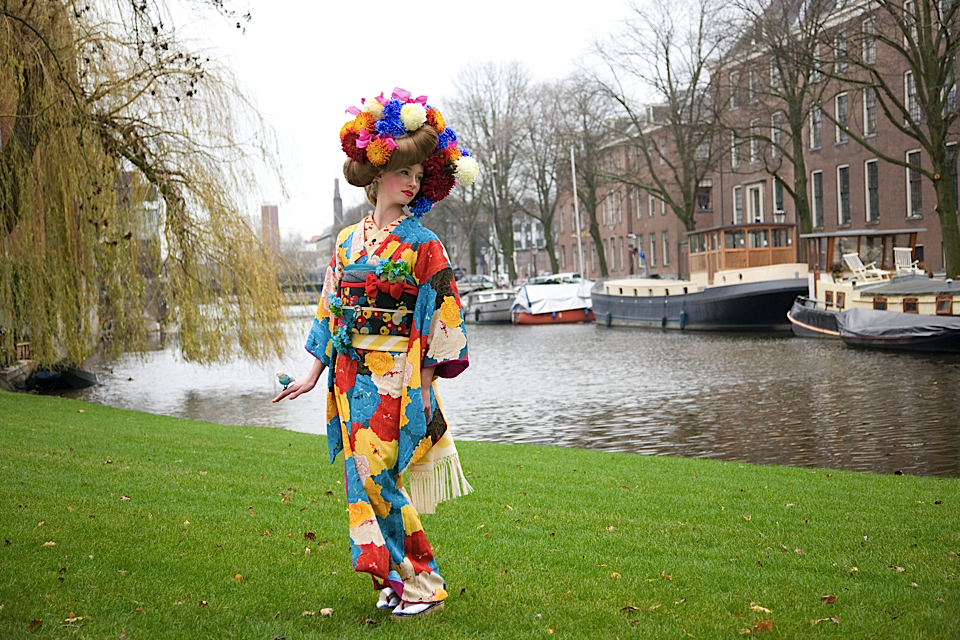
copyright- Mieko Ueda:Mamechiyo photo by Ayumi Hase
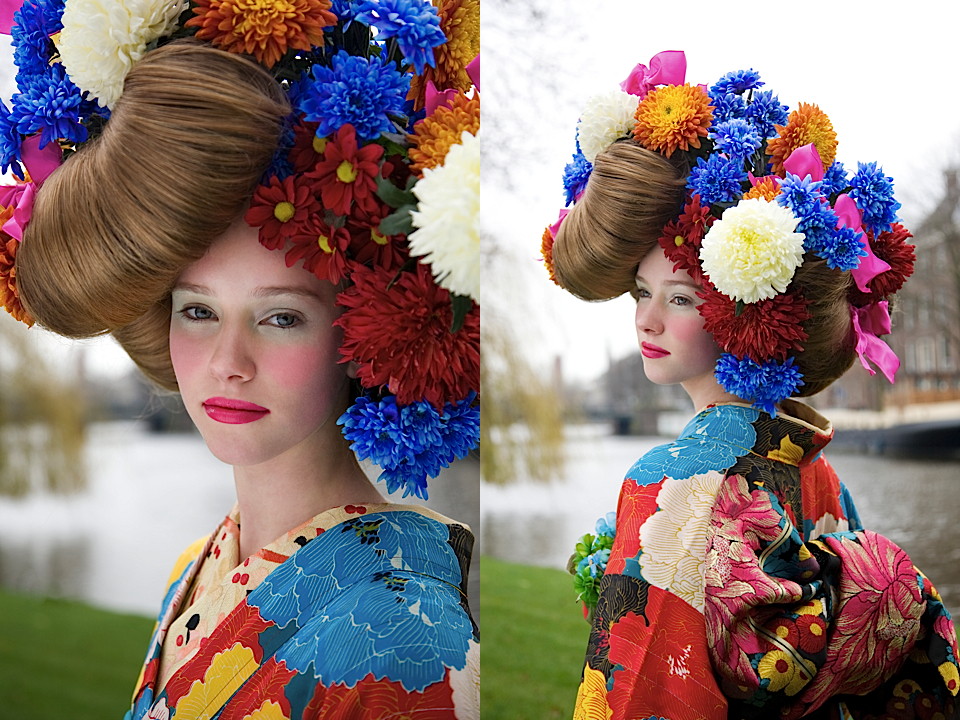
copyright- Mieko Ueda:Mamechiyo photo by Ayumi Hase
the future of vending machine
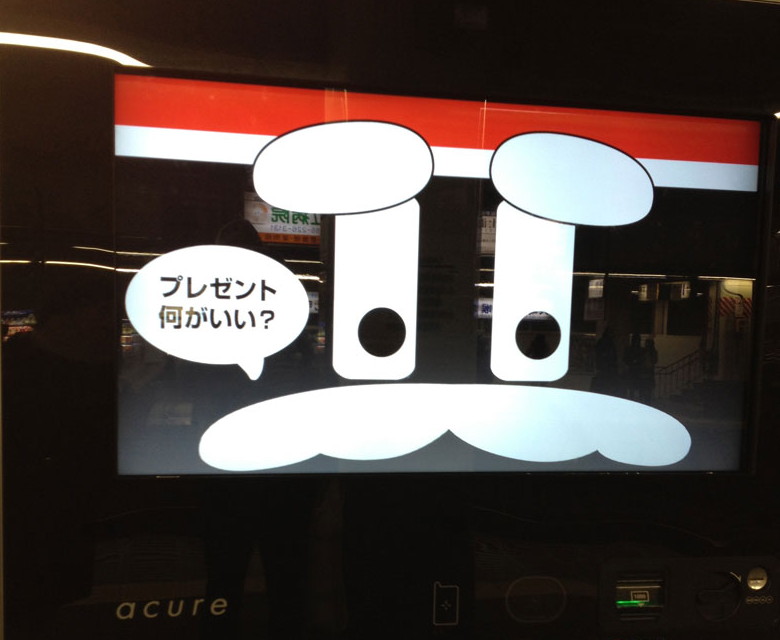
photo Kaori Leyasu
The number of vending machine in Japan is 5.218.600 (data from 2009), And its number is 2nd largest next to USA. But as you know Japan is much smaller country, you can imagine how often you can find vending machine, in every corner of the road and at the station! After big earthquake in 2011, this vending machine was the big issue as they use too much electricity. During summer time, many of them were cut off the power and stand still as the useless box… But now, they seem to find new role. Here is the new vending machine! Can you see the difference? Old one shows the real samples in the window and new one is showing the image of products.
Yes, new one is flat screen, easier to change image than old one. What happen with new vending machine is that vending machine can be the advertisement spot for everyone, not only for companies but also for individuals.The vending machine can be the interactive screen for showing your work like you tube, can be the flat digital news board, can be the urgent information for disaster…. Also with its system, design of drink can’s surface itself might be the space for advertisement. After earthquake, some people said we don’t need the vending machine and can go back to the old age when we bought things over the counter. But this technological proposal seems to give a new interactive way of selling and buying. - Text by Kaori Leyasu-
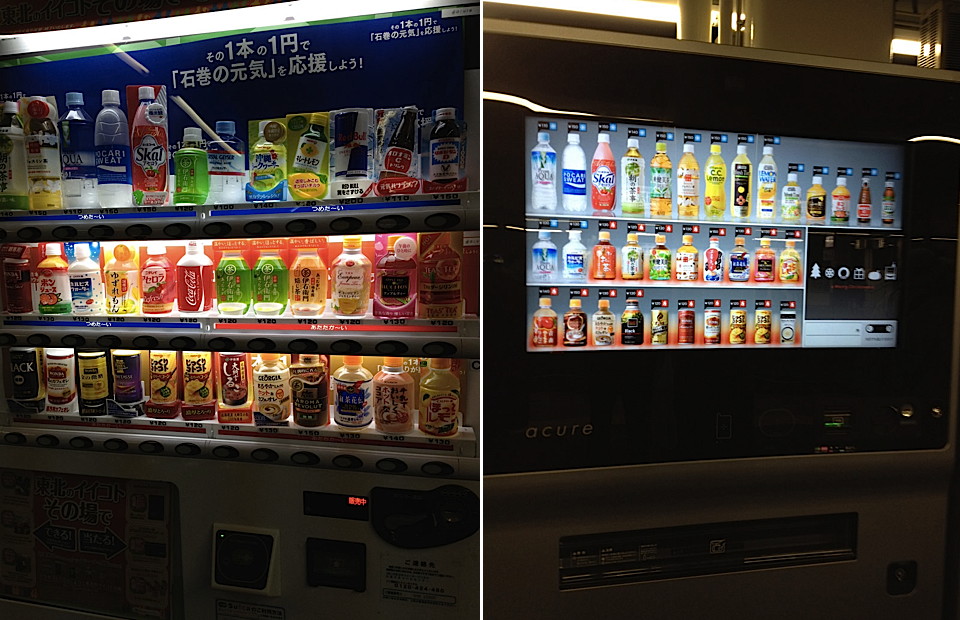
a new life with car
What is the reason to have car in our life?
As we face the serious environmental problem, as we now realize again the happiness of riding bike, do we still need cars and if so, why?
It would have been one question since long.
After 24 years, we welcomed again the motor show in Tokyo this time and
more than 375000 visitors have already visited last 4 days!
Compared with last time, it is said that less and less young generation, especially boys want to have cars.
But this motor show looks like attracting us in many different aspects.
Of course the main topic is eco related, how we can save energy, how we can be friendly to our planet.
But what is interesting is that many companies try to search the new lifestyle with cars.
Not for showing off our power and richness, but more to concerning our inner desire for moving, traveling and seeing new horizon.
Suzuki showed small eco car like motorbike for mom and kids, Mitsubishi showed house image with electric car and Toyota tries to search for the “fun to drive” using one of the most common animation and using smart phone image with car.
What is interesting is that “the reason” has become more and more specific for choosing things, fashion, interior and car.
Of course it is natural and logical but I feel it becomes more and more personalized and precise toward our life vision, where we want to live, how we want to move, with who and when?
With these personal images, we choose our shoes and car, with same stance.
Also the coloring for car was quite impressive,
Many use pure lively red for the main model and also search for the different tones of white and grey, which is more humanity and natural like earth material. Sure it will be fun to drive again. By Kaori Leyasu
working bee japanese

“Can you work 24 hours?” Such awful copy was used to be well-known in japanese business scene.Still we work longer and most of the life is eaten by work.But gradually, the mind of workers have been changing and we started to respect our own life and at the same time we started to search for the meaning of working in the office.
Recently, Kokuyo well-known and biggest general office supply maker in Japan showed new office approach.Kokuyo has been doing design award, picking up the new talent and explore the possibility of stationary, and at the same time, they are well-known with office design and proposal.
This time what I found interesting from their proposal is eco-creative, co-work and share.Since earthquake this year, the importance of eco mind has been more and more important in office and we should think how we can save energy and how we can use them efficiently.
What Kokuyo showed is not only “saving” but also creating energy using nature even in the urban office environment with full of charm and humor.
Kokuyo has an office building in the center of business area Shinagawa, but they have an aerial space on 5th floor, having small farm with seasonable vegetable taken care by employees, proposing working in the garden space not using electricity, which gives fresh ideas and inspirations toward workers for sure.Also what is interesting is that they propose the share office like nomad style in between of different industries, and they even try to work with universities.
21st century is the term from possession to sharing, and technology is the big help to let us be more “human”. Kokuyo’ s proposal tries to change “must work” toward “want to work” and pull out the happiness of working.
Now lets’ find out the happiness of working.
Kokuyo ‘s office fair was one of the most thrilling experience.
Yes, “working “ can be thrilling! By Kaori Leyasu.
20100416.jpg)
from tokyo with love !
A serie of photos made during our recent trip in Tokyo.
Presentation of BLISS forecasting for Summer 2013 by lidewij edelkoort.
And, a very long tour in the city for shopping and looking for new places and inspiring people. We loved Daikanyama !
photos by charlotte bjorklund
timeless pieces
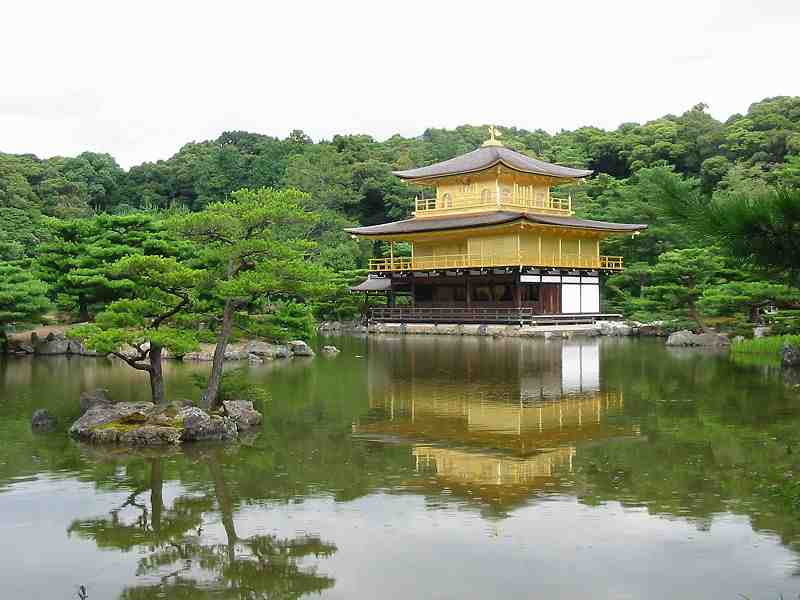
photo by Ellywa
From june 25 to july 13, Gucci has shown their timeless pieces, archives of 90 years in Kinkaku-ji temple, a zen buddhist golden temple in Kyoto.
This temple is a well-known place to visit for foreigners and even for japanese, it is a golden shining temple with beautiful garden.
In the recent years, a few shows had been held in the shrine and temple.
We strongly remember the exhibition in Daigo temple with Cartier jewelry.
Timeless is the keyword of this trend. By Kaori Leyasu
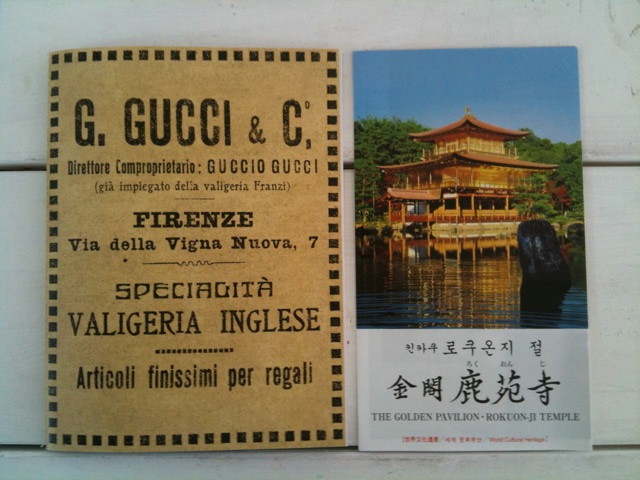
photo by kaori leyasu
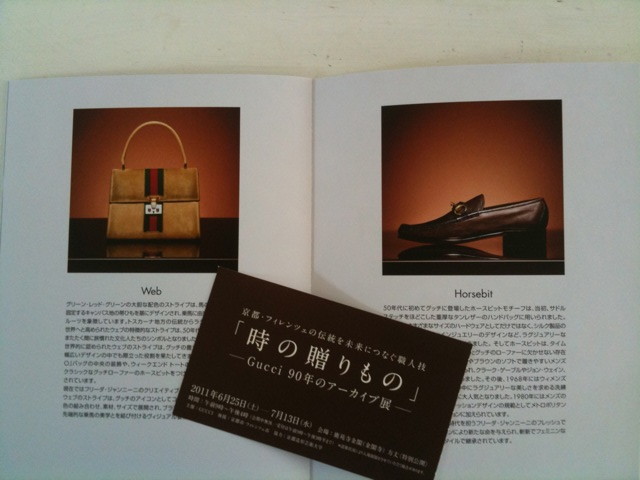
photo by kaori leyasu
hot summer

photo by morio
"As we suffered earthquake this spring, we stop a few nuclear energy port, we expect serious lack of energy coming in july and august, Hot topic now is how to survive hottest summer without using air-conditioning system (which eats a lot of energy).
One idea is "no tie" formal style. In business scene, wearing tie is rule, but this year, companies and government give an order to the employees "never ever wear tie!!!!" and express that we are joining the activity of " less energy movement".Pity for tie industry but good for TORAY, Teijin, UNIQLO who has presented "cool effect high-tech fabric" shirts, pants for summer fashion.
Another idea is "take longer vacation".
Normally we only have 3-4 days for summer vacation, but this year, people in many big industries, will take 7-10 days holiday,and also starting "house work" style, and "holiday on weekday and work on weekend" style not to consume too much energy.
Since earthquake, many young generation is in "marriage book" ( they say they don't want to die alone). Combination with long vacation summer and marriage boom, we will head directly " taking flight season" of flocks and family.Interesting movement to follow.
Third idea is the long skirt fashion boom.
Big sales around full length dress, skirts like mermaid. The reason is that Japanese women (especially middle age) don't want to show their legs and normally they wear leggins under short skirt.But with this heat, naturally they refuse such item and wear something loose and easy." Kaori Leyasu running Edelkoort's trend office in Tokyo
Kaori Ieyasu
We feel happy and honored to introduce you to our team menber Kaori Ieyasu who is running our office in Tokyo.
Kaori is a designer and she will regularly report in Trendtablet the hottest news in Japan . Enjoy!
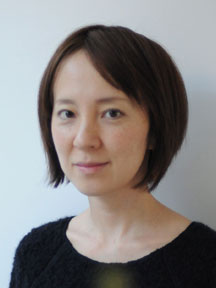
KARIMOKU NEW STANDARD X Shin Suzuki
Karimoku will unveil a new collection of wooden furniture; set against intimate images documenting the daily life of renowned artist Shin Suzuki.
For Karimoku New Standard, international design talents such as Scholten & Baijings, Sylvain Willenz and Big-Game were invited to connect their ideas with the know-how of Karimoku.
For Shin Suzuki, taking photographs is a natural act that resembles a slow, deep breath, therefore has no intention to the viewer. He leaves room to the viewer to interpret , and at the same time to expand his or her imagination in life, which in itself is an accumulation of ordinary moments.
to download the press kit click on the links:



